#Lucy the Laundress
Explore tagged Tumblr posts
Text
The Guild's actions during the story are so insane, when you think about them properly, you know? When I first read the arc with them, this moment hasn't really occurred to me, as I was too busy going nuts over finally seeing the names of the familiar writers, but now when I think of that... I am not sure, I comprehend how they managed to achieve such a ferocious reputation. I have already made a little post about how extremely dysfunctional the DOA members are, but at least those guys have a plan, which actually makes sense more or less, even despite the gang using cheatcodes/the Book. The same cannot be said of the Guild however archghhjkn. Like, what the hell were these guys even doing??? XD
So here are just some moments, which weirded me out the most
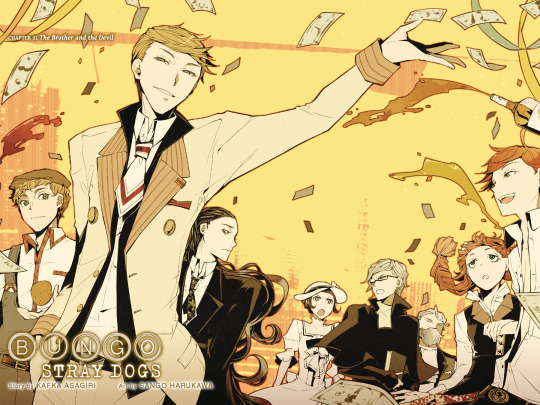
At first I'd like to address the entire story with everyone's favorite tsundere, Lucy Maud Montgomery. Her introduction leaves quuuuite an impression in the best way and nothing makes me happier than the fact, that she gets a chance to find happiness in the following chapters and actually becomes a reoccurring character! HOWEVER, her entire involvement with the Guild is super odd... I still can't wrap my head around her getting fired. She is a girl with a hella powerful ability, who got taken to the Guild from a terrible, terrible orphanage in order to fight for them in the war for the Book, so not only is she very strong, but she's also immensely dependant on the organisation and wouldn't do anything outside of its interests. Yet Lucy is also put under extreme pressure. As she herself puts it, the Guild doesn't tolerate failures and will kick her out the moment she screws something up.

Later we see that this is exactly what happens, when she messes up her first mission. Fitzgerald himself confirms that, since she failed and revealed her ability to the enemies, she's no longer useful, so now a powerful esper, like Lucy works for free as a... laundress?
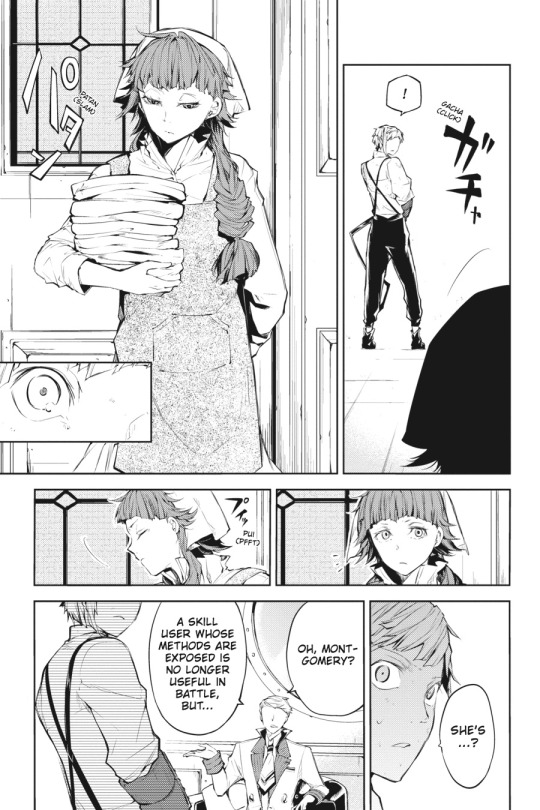
EXCUSE ME??? WHEN HAVE THE GUILD MEMBERS EVER DONE ANYTHING, BUT FAIL AND REVEAL THEIR ABILITIES?


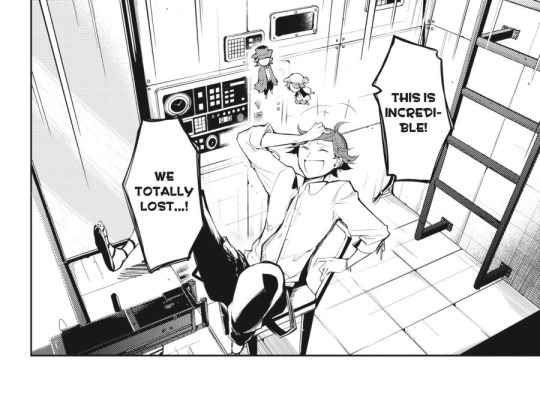

Let's be real, these dudes were successful like only once or twice...
This fact not only makes Fitzgerald look like an idiot for wasting such a talented and useful worker, because of one mistake, but also as one hell of a hypocrite, cause he is more than fine with everyone else fucking up. And in case of Lovecraft and Steinbeck: fucking up twice. To add to the oddity, we later learn, that Louisa genuinely cares for Lucy and despite her social anxiety actually stood up for her during the entire story, but even that wasn't enough to change Fitzgerald's mind on the issue, though Louisa is one of the few people, whose opinion he respects. Honestly, this is such a waste of a truly useful subordinate. And speaking of which....
The Guild has never even tried to implement Edgar Allan Poe during the war...
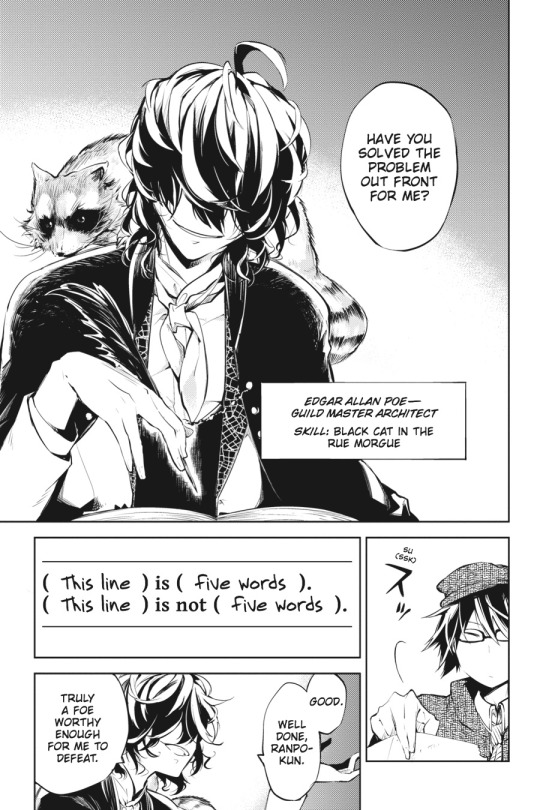
This man is actually rather op when you think of it. He can capture and neutralise literally any ability user in Yokohama (besides Dazai, Mori and Ranpo ofc) just by throwing a book at them. Seriously, as we see with Chuuya, they don't even have to read it, they just need to see the pages. Plus the book can be actually sent via email!!! So why has there been an absolute zero amount of strategies with the use of this ability??? They could actually try to catch Atsushi by sending him such email containing any of Poe's mystery stories and then safely carry him back to their base. And it doesn't have to be just Atsushi, it could be literally any of their enemies. Non-combatant, like Ranpo could use this pretty damn well to his advantage and it doesn't take a genius to understand the potential of the "Black Cat in Rue Morgue". But nooooo, it seems like everyone has just forgotten of Poe!!! (Tho to be honest, I can actually see this situation in a funny extra awfgbfggfjj. Not the main story however) The agency would never even learn of his existence, if he didn't personally decide to try to fuck Ranpo's life up. Like, what does Poe even do in the Guild? He's the master architect and, according to him, the third ranking man in the organization, but we never see him be of any use, so Idk. 🤷🏻♀️ Lucy at least got to do something, unlike this poor man.
Then there's the entire drama with the Guild's decision to destroy Yokohama. Where do I even begin...
First of all, Fitzgerald has no way of knowing that Atsushi is going to come to Moby-Dick to fight him. Poor guy is the Guild's primary goal and has already gotten himself captured once, so it would have been safe to assume that the ADA decided to hide him somewhere and not send him on any dangerous missions for the time being. That basically means Fitzgerald could have burned down not just Yokohama, but also the only person, who could actually help him find his precious Book.
But if we're to ignore this, let's also go with Wikipedia then~
"Yokohama is the second-largest city in Japan by population and the most populous municipality of Japan. It is the capital city and the most populous city in Kanagawa Prefecture, with a 2020 population of 3.8 million. It lies on Tokyo Bay, south of Tokyo, in the Kantō region of the main island of Honshu. Yokohama is also the major economic, cultural, and commercial hub of the Greater Tokyo Area along the Keihin Industrial Zone."
..........................

Good luck making up for the destruction of THIS, Fitzgerald 🖕
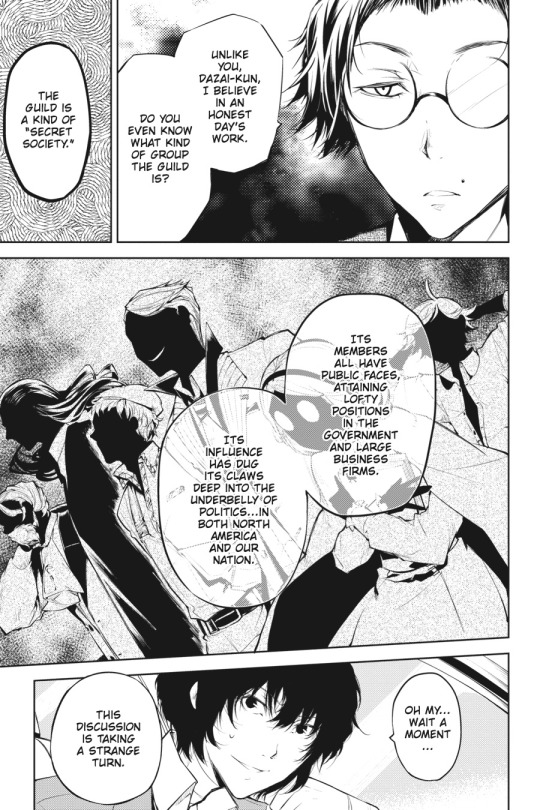
And if this in itself wasn't bad enough, most people, including me, tend to forget that all Guild members are actually big shots in the American government, which I think is very sad. Because first of all, can you imagine any of the Guild members actually working as politicians?!! The sheer idea makes me hysterical avshbgj. Like, just consider Lovecraft working as a senator or something. This eldritch horror of a man leaves the ocean once in three years at best LMAO. Second of all, I have a feeling, that the destruction of Yokohama at the hands of influential politicians from a foreign country would have resulted in an international conflict or two~ Like as if random deranged rich Americans arriving in Japan, wreaking havoc over there and destroying the second largest city in the country wasn't bad enough, these Americans just HAD to be super influential businessmen and politicians. Louisa, my dear, I understand that it wasn't your intention, but it's as close to a declaration of war as it can get, you know? Fitzgerald may be ready to do anything to resurrect his dead daughter, but I'm not sure, that the execution of himself and the rest of the Guild at the hands of the Hunting Dogs is something he'd like.
(And here's another funny thing that stems from them being politicians 🤭 As @originalartblog wittily pointed out, Fitzgerald wasting all his money fighting sskk has probably resulted in a market crash and recession over in the USA)
I also have some other questions in regards to this entire plan, such as why did they have to waste Moby-Dick just to destroy Yokohama? Yes, it works in the short term, but in the long term they loose a super powerful fortress with the stealth mode and as the practice shows, you better have a safe base, unless you want another lemon freak to blow it all up. I mean, you could just ask Lovecraft to destroy everything for free. Or, if the device is the only way to stop the giant whale from crashing, why didn't Fitzgerald just take it to a far away bunker or something and waited things out there without the need to spend millions of dollars just to survive the explosion? (And it would have been extremely funny, if during the fight with sskk he just threw the device overboard) But I think I have already rambled for long enough already atxhghbgv XD
The Guild is an even bigger mess than the DOA and I think that's glorious 🙌
#the guys stole mafia's building once just to show off and nobody has ever brought it up again#if that's not a true definition of hilarious I don’t know what is 🤭#bsd fitzgerald#bsd lucy#bsd louisa#bsd poe#bsd lovecraft#bsd guild#bsd#bungo stray dogs#bungou stray dogs#bsd meta#sort of#bsd francis#bsd spoilers#ticklinglady talks
483 notes
·
View notes
Text
A Galling Yoke, Part 2
<- Prev | Next ->
for the “That actually hurt” square on my July Break Bingo card
See this post for main info, including a masterlist and synopsis. See this post for warnings.
Word Count: 2.8k
Pairing: Sherlock Holmes x f!Reader
Rating: Teen

DO NOT TRY AT HOME THE EXPERIMENT DEPICTED BELOW.
For days, you had successfully avoided Sherlock. There had, admittedly, been close calls: once, you had been about to exit the library when you heard the floorboards creak in the corridor and decided to wait until silence had again fallen, and upon peeking out the door, you glimpsed Sherlock’s coattails as he rounded the corner; ereyesterday, you had been walking down the stairs when you spotted a familiar silhouette coming your way, and you had had just enough time to turn around and act like you had been going above-stairs instead, though your bad knee had protested at the rough reversal.
Such measures were necessary evils—necessary embarrassments. You did not want to see Sherlock. You did not want to talk to Sherlock. You could not talk to Sherlock. Too much was unsaid; too much was unknown; too little was unfelt.
So it was that you crept down the hallway in your own home, your ears tuned to Sherlock’s indelible timbre, your eyes cut on what was before you. Indeed, such focus served you well as you stepped back in time to avoid the kitchen door swinging open.
“Oh! Madam! I’m heartily sorry, I—”
“Fret not, Cook,” you reassured the scrawny woman in front of you. “You could not have seen me behind all those dishes—or, indeed, behind the wooden door. Would you have me call a maid for assistance?”
“No, no.” Cook craned her neck around the tower of plates in her arms and smiled. “Thanking you, ma’am.”
“Make no mention of it.” Gesturing to the door behind her, you asked, “Is Mrs Rogers in there?”
“The kitchen? ’Fraid not, ma’am, she be straightening out that new laundress.”
“I see. I had hoped to share my afternoon tea with her, but—”
“Oh! Well, I can have Lucy bring you a tray in your sitting-room if you wish it, ma’am.”
“Nonsense; Lucy must have plenty of chores to take care of. Since I am already here, I do not mind preparing my own tray. Although…if you wish it, Cook, feel free to join me once you have put those away.”
Cook’s eyes lowered almost as soon as they lit up. “Oh, ma’am, I couldn’t possibly—”
“Of course you could.” This time, you craned your neck to make sure she saw your smile. “If you are busy, then never you mind for today; we may have tea another time. However, if you would like to join me, please do.”
Finally, Cook met your gaze. “I would like to, ma’am. Tha— I thank you. I’ll return in a trice.”
With a nod, you let her pass before opening the door and slipping in. The pleased thrum in your veins that always arose after an auspicious social interaction vanished as you locked eyes with Sherlock across the kitchen.
“Wha—?”
“Your ladyship,” he greeted in a rush, bowing and straightening almost as quickly as he could, as though he did not want to let you out of his sight any longer than necessary. You barely had time to curtsy before he blurted out, “Do you always take your meals with your servants?”
You blinked, then you glowered. “Do you always eavesdrop on conversations in others’ private homes?”
“Not always, but sometimes a case does necessitate more underhanded methods…”
Scoffing, you turned away from him to begin preparing a tray of refreshments. “I hope, sir,” you bit out, “your now knowing that I do not treat those in my employ as a separate species is helpful to your investigation of my husband.”
A teacup rattled on its saucer as you placed it down, and you paused to take a steadying breath. How had so much bitterness seeped into your voice?
“I apologise that you thought I meant I was suspicious of you, when I had only overheard your conversation by accident, and the words I spoke were uttered out of confusion, not judgement.” Why does he sound so close? “I did not intend to offend you. In fact… Well, in fact, I had intended to thank you.”
You whirled around, but the “What do you mean?” on your lips broke into a gasp as you realised Sherlock was standing right there, right in front of you.
Holding your gaze, he said, “On my first day here without Lord Coltidge, your butler—Rogers, if I am not mistaken—told me that I had free rein to conduct my experiments if I wished to. That was kind of you.”
“Yes, well…” You adjusted your sleeves. “I recalled how those experiments helped you clear your mind when we were young, and I—” You bit down on your tongue before more bitter words about getting him out of your hair as quickly as possible could trip over it. “I wanted to save you the trouble of going between Baker Street and Grosvenor Square if I could, sir.”
Sherlock’s smile was as sudden and as dazzling as fireworks. “Would you like to…see what I am working on?”
You blinked again. “Er…” This time, you did not have it in you to glower.
“Excellent!” He grabbed your hand, effectively silencing any protest from you with the abrupt dryness of your mouth, and pulled you to the counter at which he had been standing when you entered. “I have wanted to do an experiment such as this for a while now, but my flat does not have electricity. When did your house get outfitted with it?”
You shook yourself from staring at your and Sherlock’s clasped hands to answer, “Ah, ’82, perhaps? Not too long ago.”
“Brilliant!” he exclaimed, letting go of you to fiddle with whatever needed fiddling with. You bit your lip as you watched; his excitement was unnerving, not because you disliked it, but because it reminded you of the times when you shared his excitement.
You couldn’t possibly do so now.
“Since I did not want to waste an arc lamp, this contraption here shall inform us of a successful electrical current: if one is made, these tin cans shall have opposite charges, which shall make this metal earring essentially bounce between the cans.”
“Akin to a ringing bell?” you asked, not quite understanding Sherlock’s sparse simplification but managing to visualise the described results.
“Indeed! Now, see these two bowls? The first one I filled from over there—standard pump water. This one, I filled with deionised water; I had to buy that for a few florins.”
Your eyes bulged. “A few fl— For water?”
He chuckled at you, not in the way your brother did at times, but…you shook your head and paid attention to his explanation: “’Tis worth it, I assure you, at least if you are curious-minded as I am or you are”—confound the heat rising in your cheeks at how easily he grouped himself with you!—“and I shall prove it to you. Electricity does not traverse all matter equally. That is why these wires”—he pointed to the couple of cords resting on the counter, each attached to the bell-to-be contraption—“are made of copper but wrapped in rubber.”
Gently, he took your hand again and laid your fingertips on top of the wire. “The rubber is safe to touch, see? No electrical shock.”
“But the copper is not?” you couldn’t help but ask, shifting towards the naked end of the wire. Before you could make contact though, Sherlock snatched your wrist away.
“Do not—!”
You stared up at him. “Mr Holmes?”
Eyes darting away, he cleared his throat. “It would not permanently injure you, but it would…it would hurt. A little. I suppose.” He blushed with the weakness of his argument, and you chuckled, which seemed to bolster him. “If you would truly like to touch the water, I believe I know how you may do so in a safe but curiosity-satiating way. Do you trust me?”
Your heart stuttered in your chest. “In matters of science? Unreservedly.”
He hesitated, as though he could hear the chained beast struggling in the cage of your ribs, before nodding and picking up one wire. “This bowl has the deionised water,” he said. “Ions are rather permissive of electrical charges, so do you believe this water will be safer or riskier than the pump water?”
After thinking it over, you replied, “Safer?”
“Have a little confidence in your hypothesis, my lady.” Were his smiles always so soft? “Now, I shall wrap this wire around your middle finger…”
As you watched him do so, you sluggishly wondered whether he had truly been holding your wrist this whole time—and how you had not noticed before this moment.
“I shall let go of you now, then you may dip in your index finger, but you must not touch anything besides the water. Your dress must not even skim the table. Oh—you are wearing rubber-soled shoes, are you not?”
Your lips twitched; he really had not changed. “Yes, Mr Holmes, luckily for you the Harding Street cordwainer recently made the first batch for ladies. They are quite put out that the Americas fashioned them first.”
Chuckling, Sherlock placed the second wire into the bowl, then jerked his head at you. On an inhale, you dipped your finger into the water.
You felt nothing, yet the contraption rang as Sherlock described, the earring slamming into one tin can then flying into the other then back into the first and so on.
“My!” you breathed. “Am I playing a part in this? I feel naught! Yet how could I be uninvolved?”
As he explained open and closed circuits, a cold numbness spread across you, the realisation that your resolve to resist his enthusiasm and his intimacy had crumbled so soon and so easily. But dash it all, of course restraint was difficult when Sherlock was so…was so…was so unrestrained. You had been marvelling at how familiar he was after all these years, but now, that familiarity soured in your mouth. Did he truly not feel the need, as you did, to avoid a renewed attachment? Was he truly unaffected, then, by how you two had parted ways?
“Why do you not do something, too?” you asked before you could think better of it, cutting into his spiel as sharply as you wished to cut out his disruptive presence in your perfectly contented life.
Oblivious to the edge in your voice, Sherlock smiled, and guilt sprouted in your stomach. “Why not, indeed,” he answered as he gestured for you to lift your hand out of the water. Taking both wires and submerging them in the other bowl, he said, “Electricity shall move more easily through the pump water, but it always takes the most direct path. Hence, when the wires are beside each other like this, I can put my hand in on the other end of the bowl and be unharmed.”
He did so, and shrugged at you to show he felt nothing.
“However, the closer I drift, the more I shall feel.” When his hand moved into the middle of the bowl, he added, “Ah, here, it begins: something feels off.” When his hand was nearly at the wires, he cried out, “The current is certainly passing through me now. Is this not thrilling, your ladyship? Do you not miss my experiments?”
His words struck you in the chest, knocking the breath out of you. What questions! With every inhale to regain your equilibrium, you seemed to breathe in poisonous anger as well. What questions! “Why do you stop there?” you asked. “Would it be unsafe to pass directly between the wires?”
Sherlock blinked. “Er—no, I do not believe it would be. When I first tried this earlier, I was tempted to do so even, but I had second thoughts.”
You did not speak, focused on calming yourself. You were normally quite good at controlling your words of frustration and offence—having a viscount for a baby brother and a pompous old earl for a father would do that to a lady. What about Sherlock made you speak out of pain that you didn’t even acknowledge to yourself?
Before you realised how he might take your silence, Sherlock moved his hand between the wires. The next instant, he yanked it out of the water and yelped, “Bloody hell!”
Shaking his hand at the wrist, he gave you a sheepish look. “Pardon my language, your ladyship. I did not expect… I shall have to note down that doing that actually hurts…”
He glanced around for his notebook, and for both your and his sakes, you tried to joke, “Have I aught to pardon? You shall remember that you and I learned that language side by side at Ferndell.”
Turning to you, Sherlock was most certainly not laughing. Bemusement rent the smoothness of his brow, and what typically gave you a boost of pride—how often did one befuddle the great Sherlock Holmes, after all?—only sickened you now, as hurt clouded his expression. “There is bitterness in your tone and mien,” he remarked. “Have I done something?”
The guilt that had sprouted in your stomach took strangling root in your hip, in your knee, in your ankles, and you suddenly had to lean on the counter for support. “Mr Holmes…” How could you answer that question, so simple yet so complex? You had thought avoiding him would protect you, but maybe it would be more effective to face your muddled emotions head-on. “Perhaps it is time we talk.”
“I would like nothing more”—he hesitated—“my lady.”
You took a deep breath. “Why did you take this case?”
He took the wires out of the bowl, to all appearances to stop the contraption’s dinging but, you knew, truthfully to occupy his hands. “I…wanted to see you.”
Your eyebrows shot up. Of all answers, you had not expected that.
Seeing your face, he rushed out, “When your father came to me, I saw it as my opportunity. It has been years, I know, but I never stopped—”
“Why did you not write?” you burst out. “Or call on me? You knew the Voss London address! If you had somehow forgotten it, the walk from Ferndell Hall to Jotyard Manor so you could ask my brother is very little time compared to fifteen years!”
Sherlock grimaced. “Petal, you know how I struggle with…with… See, it was always you who could explain to me which social avenues are permitted and which are disallowed! I had never visited your house in Town, nor had I visited your estate, come to think of it—you always came to Ferndell. How was I to know I could simply call on you?”
Incredulous, you stood with your mouth agape.
He rubbed his face. “I see now that I…maybe I ought not to have taken the case after all,” he sighed. “You do not seem to want to see me, although I have been struggling to understand why.”
The guilt flowered, its blossoms stuffing your lungs.
“At first,” he mused, “I thought you were being distant because the years had cleaved you to your station. You seemed to look down on my work—my ‘exploits’, as you called it. You acted the part of an earl’s daughter more dutifully than I think your governess would have thought possible. You revoked the permission you had happily given me to call you your Christian name. I was displeased but satisfied with these findings, then today, I…”
He looked at the door behind you, and you remembered the conversation with Cook he had overheard.
“No. Evidently, you are the same girl I knew who does not think she is better than everyone else for simply being born a Voss.” Turning back to you, his eyes pierced you. “Why then do you sneer at me, your ladyship?”
Sneer? “Do you— Do you seriously not understand why the very sight of you hurts me?”
Loathsome tears stung the backs of your eyes, but even through your blurry vision, you could make out the surprise on Sherlock’s face.
The guilt withered.
“So it is then,” you said. “In that case, I can only imagine how little regard you have for the battered vessel in my chest.”
The door behind you opened. “Ma’am, I—”
“Cook, I have prepared the sandwiches and the cups, but I fear I have forgotten to boil the tea.” Brusquely, you went towards the door. “Would you please prepare that, then bring the tray to the… Oh, I do not know, how do you like the yellow room?”
“I never been,” she replied, eyeing something over your shoulder, “but I’ll ask Lucy for directions. Everything all right, ma��am?”
“Certainly,” you said as you blinked away your tears. At the threshold, you turned back briefly and curtsied, but did not dare lift your gaze.
Thank you for reading. Please let me know if you would like to be tagged for updates. :) Feedback is always welcome! Nota bene that I totally screwed with scientific history in London here though; I tried to stay true to the timeline of electrical and deionisation technology, but yeah no, parts of Sherlock’s experiment would not have been possible for at least a couple of decades. Sorry! 😂
#sherlock holmes x reader#sherlock holmes x you#henry cavill sherlock x reader#enola holmes#a galling yoke#x reader#the dimensions of fandom
80 notes
·
View notes
Text
M U S E R O S T E R ! ( AS OF 05/07/2024 )


ORIGINAL CHARACTERS aanisah, aladdin (animated and live action), rug maker and seller and younger sister of aladdin, fc: golshifteh farahani
josephine de chagny, the phantom of the opera (musical), missing viscountess masquerading as a opera chorus girl and twin sister of raoul de chagny, fc: taylor russell
camila charming, cinderella (live action), princess and twin sister of prince charming (kit), fc: jess alexander
juliet desrosiers, beauty and the beast (animated and live action), princess and younger sister of the beast (prince adam), fc: havana rose liu
nicolette danielle renata devereaux, princess diaries 2: royal engagement (2004), famous actress, socialite and younger sister of nicholas devereaux, fc: camila morrone
emily fitzherbert, tangled (2010), royal baker and younger sister of eugene fitzherbert, fc: grace caroline currey
annelise josefine hubermann, the book thief, laundress and combat nurse and third and youngest child of hans and rosa hubermann, fc: ellise chappell
princess amina luna magnifico of rosas, wish (2023), singer and musical prodigy and the only daughter of king magnifico and queen amaya of rosas, fc: rachel zegler
anisette mellark, the hunger games (books and films), baker and peeta mellark's older sister, fc: cailee spaeny
lucy gray peterson, tuck everlasting, immortal poet and wanderer.
september plinth, the hunger games: ballad of songbirds and snakes (book and film), aspiring television producer turned nurse and sejanus plinth's twin sister, fc: paulina chavez
elizabeth rose sanderson, hocus pocus, good witch and fourth and youngest sanderson sister, fc: jennifer connelly
wendy scott, yellowjackets (not caught up on season two), yellowjackets defensive midfielder and coach ben scott's younger sister, fc: lisette olivera
jane van dort, the corpse bride (2005), victor van dort's younger sister, fc: ella hunt
CANON MUSES (all canon muses are subject to personal headcanons) lillian "lil" ashlock, the hunger games: the ballad of songbirds and snakes, book and film compliant, fc: isabel deroy-olson
ella "cinderella" baudin, cinderella, disney, rodgers and hammerstein musical based, fc: brittany o'grady
johanna barker, sweeney todd: the demon barber of fleet street, strictly musical based, fc: maria bilbao
juliet capulet, romeo and juliet, canon compliant with influences from rosaline (2022), fc: isabella merced
annie cresta, the hunger games, films and books compliant, fc:
esme cullen, the twilight saga, film and book compliant, fc: fiona palomo
regina george, mean girls (2024), musical based, fc: reneé rapp
lisa swallows, lisa frankenstein (2024), canon compliant, fc: kathryn newton
maría vasquez, west side story (2021), fc: rachel zegler
michelle "shelly" webster, the crow, 1994 film based, fc: whitney peak
carrie white, carrie, 1976 and 2013 film based, fc: sarah catherine hook
addison wells, zombies, canon compliant, fc: megan donnelly
sally, the nightmare before christmas, canon compliant, fc: ella purnell
#muse roster.#new muse roster post that's more accessible and less cluttered with gifs!#italicized names means new muse!
4 notes
·
View notes
Text
KIDZ!
The Young People of the Lucyverse ~ Part 3

W.C. Fields famously warned performers never to work with children or animals. Luckily for us, Lucille Ball consistently disregarded his advice. Here’s a look at some of the young performers and characters of the Lucyverse.
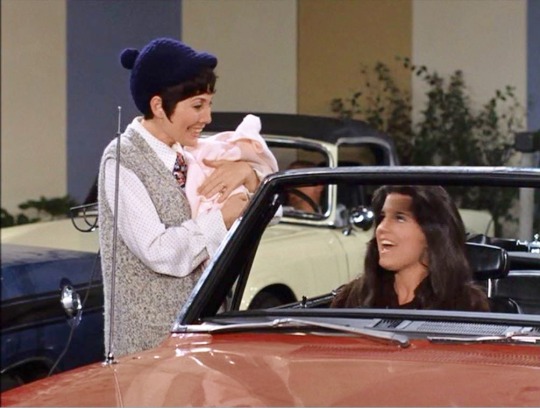
“Lucy and the Drive-In Movie” (1969) ~ Jackie Berry is a married friend of Kim’s who has a newborn named Wendy. Her husband is said to be in the service. Jackie Berry uses her married name for the character. She ws the real-life wife of Ken Berry from 1960 to 1972, an actor championed by Lucille Ball.

“Lucy and Jack Benny’s Biography” (1970) ~ Lucy plays Jack’s mother and Michael Barbera plays Benny as a boy. Barbera was a child actor who was 12 years old at the time of filming. He accrued 18 screen credits before leaving the industry.
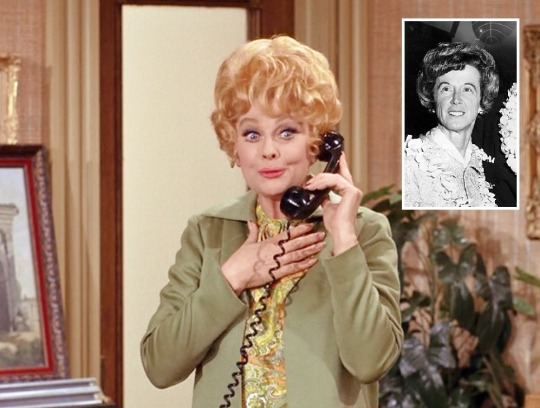
“Lucy Cuts Vincent’s Price” (1970) ~ Lucy says she previously talked on the phone to Mrs. Vincent Price when arranging entertainment for a big party the Price’s threw. In 1970, Vincent Price was married to costume designer Mary Grant (inset photo), although her name is never mentioned here. Making small talk on the telephone, Lucy asks about Little Vicki. This is a reference to the Price’s 8 year-old daughter, Victoria. Although Lucy visits their home, both characters remain off-screen.
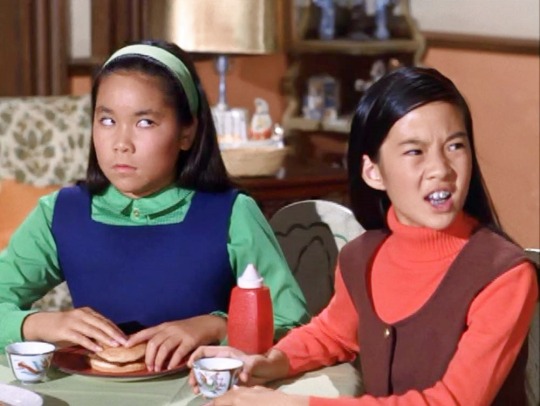
“Lucy the Laundress” (1970) ~ Lucy smashes into a laundry truck. In order to pay for the repairs, she has to go to work at the laundry and encounters the owner’s two daughters Sue Chin Wong (left) and Linda Change Wong (right). Linda is played by Rosalind Chao who makes her screen debut with this episode. She created the role of Soon-Ye Klinger on “M*A*S*H” and “After M*A*S*H” but is perhaps best known for playing Keiko O'Brien on “Star Trek: The Next Generation” and “Deep Space Nine.” During that series she also filmed The Joy Luck Club. More recent credits include “Blackish,” “This is Us,” and “The Catch.” Heather Lee (Sue Chin Wong) makes her screen appearance in this episode. When Lucy meets the sisters, she greets them in an exaggerated and condescending Chinese accent. The girls look horrified and answer back in voices totally devoid of any Asian influence. To further the humor of Lucy’s backward thinking, the girls are eating hamburgers with ketchup, a typical American-style meal.
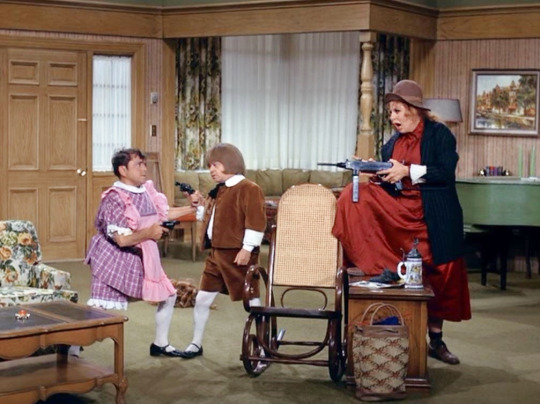
“Lucy and Ma Parker” (1970) ~ A criminal mastermind (Carole Cook) enlists two little people (Jerry Marin and Billy Curtis) to play her ‘children’. Milton (Marin) is dressed as ‘Little Mildred’ in the style of child star Shirley Temple. Curtis plays Herman Golab, who is dressed as Buster Brown.

“Lucy and the Italian Bombshell” (1971) ~ Harry’s former flame Donna Colucci (Kaye Ballard) is married and has a large brood of children: Ricardo, Anna Maria, Louisa, Luigi, Vincenzo, Dino, Lucrezia, Alfredo Jr., Margarito, Bruno, Rosa, and Frederico - all of whom appear uncredited.
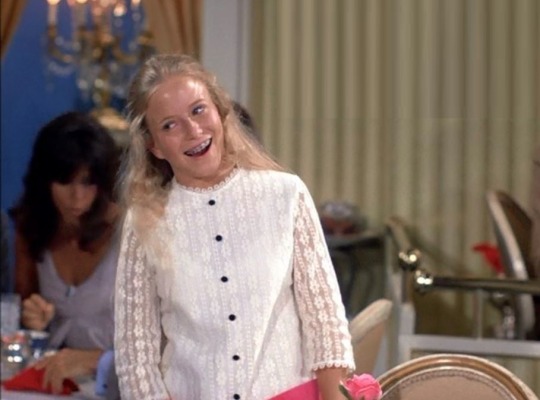
“Lucy and Donny Osmond” (1972) ~ Lucy takes her pre-teen niece Patricia (Eve Plumb) to see her favorite singer, Donny Osmond. Plumb is probably best known as the middle daughter, Jan, on TV’s “The Brady Bunch” (1969-74). She filmed this episode simultaneously with “The Brady Bunch” which aired Friday nights on ABC. This is her only time acting with Lucille Ball. Coincidentally, Desi Arnaz Jr. made a guest-appearance on “The Brady Bunch” in 1970 where he was the ‘dream date’ of Jan’s sister Marcia (Maureen McCormick).
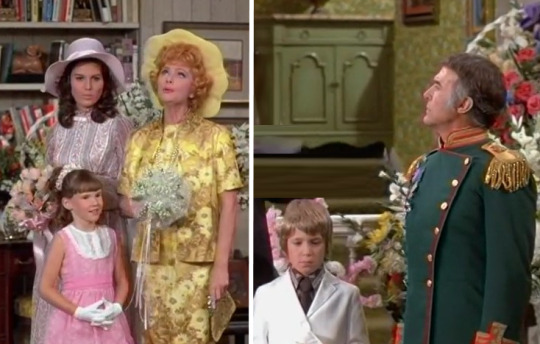
“Lucy and Her Prince Charming” (1972) ~ Harry hastily arranges a home wedding ceremony for Lucy and a Prince (Ricardo Montalban) - including a flower girl and a ring bearer - played by two uncredited young actors.
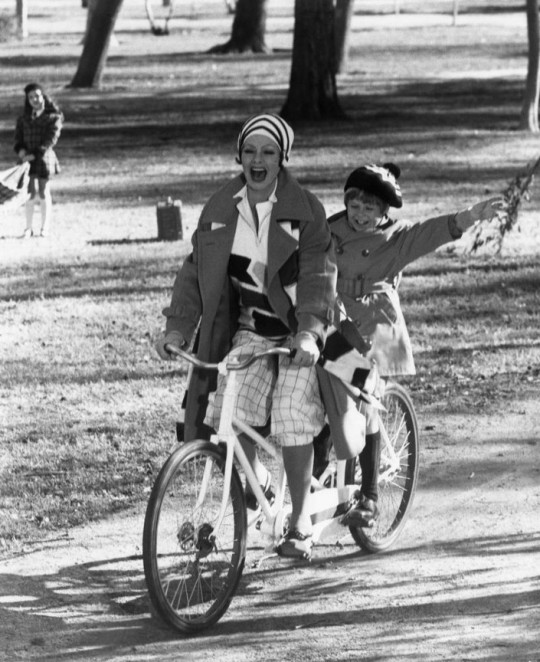
Mame (1974) ~ Lucille Ball plays Auntie Mame to orphaned Patrick Dennis, played by Bruce Dern as a child.
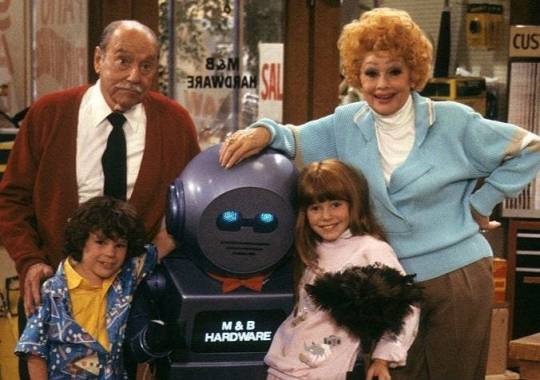
“Life With Lucy” (1986) ~ Lucy Barker and Curtis McGibbon (Gale Gordon) are grandparents to Becky and Kevin McGibbon. Becky is played by Jenny Lewis. Ten year-old Lewis appeared in all 13 episodes, only 8 of which were aired.
“Yes, Lucy was a bit rough around the edges, and yes, she constantly smoked cigarettes on the set. She would pull her face back with tape, sort of like a cheap face-lift.“ ~ JENNY LEWIS
Philip Amelio (Kevin McGibbon) made his screen debut on “Life With Lucy” at the age of 10. He played Stephen Baldwin’s younger self in the film Born on the Fourth of July (1989). He gave up acting by his early teensPhilip died in 2005 at the age of 27 due to a mis-diagnosed bacterial infection.

Kelli Martin (right) played Becky’s friend Patty in two episodes of the series. Born in 1975, she made her acting debut at age 7 and went on to be seen as an Emmy-nominated regular on “Life Goes On” (1989-93) and “Christy” (1994-95) in which she played the title character.
BONUS KIDZ!
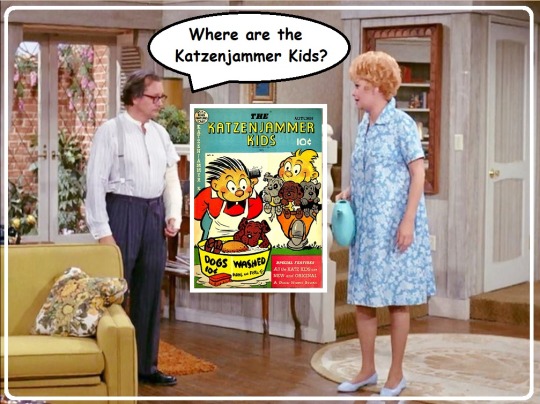
“Lucy the Diamond Cutter” (1970) ~ German diamond cutter Gustav (Wally Cox) calls Kim and Craig “the Katzenjammer Kids.” The Katzenjammer Kids was a comic strip created by German immigrant Rudolph Dirks which appeared from 1897 to 2006. The strip featured twins Hans and Fritz, who rebelled against authority.

“Lucy and the Generation Gap” (1969) ~ In the final sequence of the musical episode set in outer space, the Carters sing “Kids” a song written by Lee Adams and Charles Strouse for the 1960 Broadway musical Bye Bye Birdie. The musical was filmed in 1963. This song is originally about the generation gap, so it requires the least lyrical changes. It was sung on stage and screen by Paul Lynde, playing the father of free-thinking kids obsessed with an Elvis-like rock and roll singer.
#Lucille Ball#Kids#Children#Here's Lucy#Gale Gordon#Desi Arnaz Jr.#Lucie Arnaz#TV#Wally Cox#Mame#Kelly Martin#Philip Amelio#Jenny Lewis#Life With Lucy#Kelli Martin#Ricardo Montalban#Eve Plumb#Jack Benny#Vincent Price#Carole Cook#Jerry Marin#Rosalind Chao
4 notes
·
View notes
Photo

Lucy Liu for The Laundress New York: #OurBeautifulMesses
129 notes
·
View notes
Note
In yesterday’s Dracula Daily update, Mina mentions she is “only taking one change of dress”. 1) Was this a common occurrence for short trips or because of the circumstances? 2) Would both dresses be ‘traveling dresses’? 3) I’m assuming one dress means the top-most layer & she packed multiple chemises, etc. Could other undergarments (i.e. petticoats) be re-worn between washes? 4) Would she have been able to launder her clothing while travelling? Thank you.
Good questions!
While I'm not 100% sure, I believe her mentioning that she's only taking one change of dress is because that's such an unusual thing to do. To my eyes, it highlights how quick and desperate her flight to Jonathan is: she's dropping everything and preparing only the bare minimum so she can get to him as quickly as possible. I believe it would have been more common, for a trip all the way to Hungary, to bring the full trunk she's opting to have Lucy keep in readiness for her instead.
Given Mina's practical nature I'm going to assume they're both travelling dresses, but I suspect that could vary from person to person in similar circumstances. Eg she might pack two travelling dresses- hard-wearing materials, colors unlikely to show the soot and dirt of rail travel, skirts that clear the ground, etc. -but another woman might have chosen one travelling dress and one fancier dress. That seems like a more individual question to me.
She would almost certainly pack multiple chemises or pairs of combinations, yes. Anything that didn't touch the skin directly could definitely be re-worn between washes, unless it got particularly dirty (and even then, sponging the hems of one's petticoats and even outer skirts was a common way to remove dirt without a full wash).
As for laundry, Mina likely didn't do it herself even at home- it was quite common to send your clothes out to a laundress, even for middle-class families and individuals. As you can see in Bernadette Banner's recent video, laundry was a strenuous multi-day undertaking back then, which is why people could make decent money doing it as a full-time job. Anyone who could remotely afford to outsource it, did. I haven't done deep research on this, but it's my impression that most hotels of the caliber Mina's likely to be staying at would employ a laundress (or multiple) on their staff to wash guests' clothes.
#ask#anon#history#1890s#dracula daily#dress history#social history#I'm always slightly baffled by pop history sources that insist everyone did their own laundry and made all their own clothes#in the 19th century#like. if that's true then why were Seamstress and Laundress/Washerwoman viable occupations?#what do you think they were sewing and laundering?#the 1% are by definition a small category of society so there couldn't be enough business from them alone#to support entire thriving trades around making and washing clothes#that's not to say NOBODY did it themselves. of course people did#but like. clearly not everyone who wasn't rich
408 notes
·
View notes
Text
Lodging House Quick List
Most information, besides current status, is based on the United States 1900 Census. For more details, check here, here and here.
Duane Street Lodging House
Also known as the Brace Memorial Lodging House and The Newsboys Lodging House. Closest house “Newspaper Row”. Could accommodate up to ~600 boys. Address: 9 Duane Street Opened: 1874 Superintendent: Rudolph Heig, age 36 (wife Augusta; had 5 children, but none are listed) Assist. Superintendent: none # of Servants: 3, plus 1 older gentleman (an engineer); one cook, one house keeper, one servant # of Newsboys: 12 Rooms: 7 floors, with first level in use by street level shops; dining room, kitchen, laundry, staff rooms, reading room, school room, gym, attic, and washrooms with cold/hot water; several dorms w/bunks (abt. 50-100 beds), plus one dorm with curtained beds. Current Status: Demolished sometime in the 1960s; police headquarters is roughly where lodging house was located.
West Side Lodging House
Closest house to what would be now known as Grand Central Station. The census calls it the West Side Boys Home. Could accommodate up to ~150 boys. Address: 201 W. 32nd St. Opened: 1884 Superintendent: Benj W. Tice, age 46 (wife Mary; 3 children) Assist. Superintendent: William B. Hughson, age 34 # of Servants: 7; one engineer, two watchmen, one cook, one waitress, one laundress, and one chambermaid. # of Newsboys: 4 Rooms: 5 floors; had a dining room and assembly room; 16 dorms Current Status: Demolished (date unknown); would have stood roughly where Madison Square Garden/Penn Sation is.
Tompkins Square Lodging House
Designed in part by Calvert Vaux, who designed Central Park. Built in a Victorian Gothic style. Address: 297 Eighth St. (according to the census-- it was generally given as 295 E. 8th St. at the time) Opened: 1887 Superintendent: Moore Dupuy, age ? Assist. Superintendent: William Grosvenor, age 35 # of Servants: 9; two clerks, two porters, one watchman, one “janitress” (a janitor), one cook, one chambermaid, and one waitress. # of Newsboys: 4 Rooms: 4 floors; dining room and classrooms, plus bathrooms; dorms took up 3rd and 4th floors (but number of boys that could be accommodated is unknown). Current Status: Building still stands; it is now an apartment co-op (and a really nice one at that, if we go by the real estate listing images), and is a designated landmark.
44th Street Lodging House
Also designed by Calvert Vaux, and had a clock tower. Could accommodate up to 125 boys. Address: 247 and 249 E. 44th St. Opened: 1889 Superintendent: William Wood, age 26 (wife Lillian) Assist. Superintendent: none listed # of Servants: 6; one cook, one night watchman, one servant, and three janitors # of Newsboys: 5 Rooms: 5 floors; 3 dorms w/ about ~100 beds; also had a library, kitchen, reading room, laundry, bathrooms, gym, audience room, school rooms, plus kindergarten rooms (two) and a nursery. Also had brush shop (the “crippled boys’ brush shop”), where brushes were made. Current Status: Demolished, sometime in the 1930s; it is now the site of some luxury apartments
Fogg Lodging House
TBA
Elizabeth Home for Girls
This home was a little different, in that it housed less people, but was more or less a training grounds for girls, rather than just a place for them to sleep in the evenings. Address: 307 E. 12th St. Opened: 1892 Matron: Elizabeth Hurley, age 73 Assist. Matron: none listed, though possibly Annie McIntyre would count (age 36, and listed as an inmate, but could’ve been an instructor to the girls) # of Servants: none listed; 13 girls listed as “laundress”, but also as inmates (including Annie) # of Newsgirls: none Rooms: 4 floors; storage rooms, trunk room, 2 dining rooms, several laudnry rooms (washing, drying, ironing), bathrooms, kitchen, matron’s rooms; 8 dorms with several beds, 6 single bedrooms Current Status: Still standing, and also a landmark; it is currently a co-op
Great Jones Street Lodging House
TBA
St. Vincent’s Home (Manhattan)
TBA
Brooklyn Lodging House
Founded by the Brooklyn Children’s Aid Society (unaffiliated with the organization in Manhattan). AKA the Newsboys’ Lodging Home, Newsboys’ Home, Children’s Home, and Working Boys’ Home. Address: 61 Poplar Street Opened: 1884 Matron: Lucy Kirkby, age 62 Assist. Matron: Cornelia Shaw, age 54 # of Servants: 5; one watchman, one cook, one porter, one laudnress, and one waitress # of Newsboys: 8 Rooms: 4 stories; storage room, gym, bathrooms (with 5 tubs, and hot/cold water), kitchen, dining room, reading room, reception room; 2 larger dorms (one holding about 50 beds, the other about 100), and a smaller room with private beds, plus one small room for sick boys Current Status: Still standing; currently high-end condos
St. Vincent’s Home for Boys (Brooklyn)
Also sometimes referred to as the Newsboys’ Home. Address: 7 Poplar St. Opened: 1869 Chaplain: Friar William L. Blake Assist. Chaplain: none listed # of Servants: 1; specific job isn’t listed # of Newsboys: none listed Rooms: Unknown
5 notes
·
View notes
Text
Lucy turned and pulled a pair of men's pants from her wardrobe; she'd "borrowed" them from the laundress to make exploring easier. "They go over your legs," she explained. "Alright?"
Little Mermaid AU
@ask-lucy-jefferson
Prince Gabriel always wondered what life was like in the human world, he even collected little trinkets that got lost at sea and kept them in a little cave hidden from his father. His father strictly forbid anyone from swimming up to the surface but that didn’t stop the prince from doing so occasionally. He noticed a shadow on the surface of the water and swam up to investigate. The prince poked his head up out of the water and saw a ship that looked like it was celebrating something.
237 notes
·
View notes
Text
america’s women, gail collins
chapter 14: reforming the world: suffrage, temperance, and other causes
“like all things too long postponed, now gets on everybody’s nerves”
at the turn of the century, the woman suffrage movement revolved around susan b. anthony and elizabeth cady stanton (like before the civil war) - they were friends for more than 50 years
anthony - never married, stanton - wife and mom
susan b anthony regarded children and maternity as a betrayal of the cause
stanton was an idea person - speech writer and essay writer, anthony was an organizer, worker bee - stanton was a lot more self confident. they both wanted emancipation of slaves
“they turned on old friends and aligned themselves with a racist benefactor, arguing for woman suffrage by comparing educated white women like themselves to semiliterate black men who were getting the ballot first”, “it was a bitter, dark period during which stanton shocked her friend frederick douglass with her denunciation of ‘patrick and sambo and yung tung making laws for... the daughters of adams and jefferson”.
the women’s movement split, leaving radical feminists like cady and stanton on one side, and the more moderate women, like lucy stone on the other.
“much of the money to run anti-suffrage campaigns came from the liquor industry, which realized it would be out of business if women get to vote on prohibition”
yellow was the color for the suffrage movement - 1912 there was a parade for women’s right to vote in Manhattan - attracted 10k marchers -(cut across class lines - corset makers, nurses, social workers, schoolgirls, writers, society women, laundresses, teachers)
“there is no alice paul. there is suffrage”
american women hard parades - but british women were willing to smash windows, throw rocks, get arrested - emily davison - she threw herself in front of the king’s horses during the running of the english derby in 1913 - and died
alice paul spent her political apprenticeship with the english suffragists. she didn’t like the state by state strategy and felt women needed a constitutional amendment
woodrow wilson - “the foundation of every evil in this country” (what he thought of suffrage in his youth)
carrie catt was a more mainstream suffragist - she was well-to-do, well-educated and respectful of authority - and she and her friends didn’t like alice paul
alice paul picketed the white house, people were arrested, trips to police station, fines, shot at - she served a six month sentence
“in the sympathy of women”
1913 was when alice paul stole the thunder from woodrow wilson’s inauguration with her parade. ida wells-barnett - black journalist and activist arrived to the march- part of a 60 member delegation of african american women from alpha suffrage club in chicago - paul did not want them there to placate southern suffragists
lynchings after reconstruction - part of political and social intimidation - 1918 in georgia, mary turner - a pregnant black woman tried to intervene a lynching of her husband, she was tortured, her body slashed open and the fetus pulled out before she was burned to death
the georgia federation of white women, president - said that the lynching would not end “until you teach your people not to molest the whites”
“lips that touch alcohol”
most women were not interested with the right to vote - they were concerned with temperance. “the liquor industry was right, many women wanted to vote just so they could use the ballot box to ban the sale of alcohol”
this entire chapter is a bit eye roll - basically paints these women as shrill harpies...... women wanted to shut down saloons and drive all forms of alcoholic beverage out of the country
“assaults” on saloons - occurred in 1k communities, urged by male temperance leaders
prohibition became the law in 1919
“temperance advocates could be mind-bogglingly self-righteous, and they tended to blame alcohol for everything bad except the weather”
frances perkins, secretary of labor in franklin roosevelts admin, apparently was “stunned” that the impoverished residents didn’t drink (because she thought alcohol caused property)
“ a drunken husband was an emotional burden, a potential physical danger, a drain on family finances”
carry nation - walked into an elegant bar of the hotel carey in wichita , kansas - threw stones at a huge painting of “cleopatra at the bath” ripping the canvas
she was apparently obsessed with the evils of alcohol and tobacco - she was not a temperance leader, part of a “lunatic fringe” - but millions of mild mannered american women defended her ends, if not her means
“do everything”
the women’s christian temperance union - biggest mass political organization of american women in h istory - 1890s 10x as many new york women were in the wctu as in all the suffrage groups combined
frances willard (president of wctu) for twenty years - “although she would hint vaguely about other romances, all of Willard’s known close personal relationships throughout her life were with women) --- this person is homophobic.....
she encouraged people to fight for reform in which every way struck them as best
women talked about “general sanitation, improving education, child labor laws”
“beautiful white girls sold into ruin”
the purity campaign - third strand in women’s reform movement - like temperance, its bottom line was “forcing men to behave”
campaigned for men to wear white ribbons, showing they had taken a pledge to be sexually pure until marriage and faithful to their wives after
they wanted to censor movies, and cover up paintings of naked women “nude art never helped a soul to belief in the lord jesus christ” a protest against the bostom museum of fine arts. frances willard supported this but her priority was “more serious” - raising the age of sexual consent for girls, which was as low as ten years old in a number of states
1920- wtcu succeeded in making it illegal to seduce a girl under eighteen
purity campaign, like temperance (according to this author) was based on the idea that middle-class women were morally superior and therefore had the right to tell everyone else what to do
“but also like temperance it targeted a real social problem that brought its worst evils home to torture innocent housewives”
“they did not approve of trying to keep venereal disease in check by treating prostitution as a public health issue” - in 1970 st. louis legalized brothels and required licensed prostitutes to pass weekly health inspections “only to have that program killed by opposition from clergymen and female reformers. elizabeth cady stanton also hated the idea - they did not want men to sleep with prostitutes safely, but to stop using women as sex objects altogether”
ending prostitution had always been a primary goal of women’s reform movements - the sexual purity campaign created a panic over “white slavery” - white girls would be used by pimps in brothels - “the idea fit into white women’s gut conviction that none of their sex - and race - would fall into prostitution voluntarily” the author refers to this as “hysteria”
“can they not use self-control?”
sexual purity crusaders blamed “falling birthrate” on venereal disease - but women were using birth control
anthony comstock
artificial birth control wasn’t an issue for which women reformers had much sympathy - women’s rights advocates argued for “voluntary motherhood” - the right to say no to marital sex
“the idea that women would want to indulge in intercourse while avoiding pregnancy was strange to many people who still believed that women were too pure to be interested in sex”
“what every girl should know”
margaret louise higgins - middle child in eleven, father was a stonemason
her older sisters earned money - and margaret went to school to be a nurse
sanger marriage was troubled - she gave birth to three children, and her husband was not a good breadwinner
women “who were ruining their health with too many pregnancies” she met in lillian wald’s visiting nurses
opened the first birth control clinic in America
0 notes
Photo

McCarty, Oseola (07 March 1908–26 September 1999), philanthropist, was born near Shubuta, Mississippi, the daughter of Lucy McCarty and an unnamed father. Largely raised on a small farm by her maternal grandmother, Oseola was taken as a child to visit her mother in various turpentine-processing camps, where her mother was following her stepfather. In 1916 her mother relocated the family to Hattiesburg, Mississippi, where Oseola would spend the rest of her life. McCarty began school at nearby Eureka elementary but had to drop out in the sixth grade in order to care for an aunt who later required home care. While her mother supported herself by cooking for a local county circuit clerk and selling candy at a nearby elementary school, McCarty worked as a laundress. She developed a habit of thrift at an early age, opening her first savings account at First Mississippi National Bank. Perhaps due to family responsibilities McCarty never married or had children. She lived an extremely frugal lifestyle. She preferred to walk rather than ride in an automobile. She also did without newspaper subscriptions, cable television, and even (until very late in life) air conditioning. Her deepest abiding interest outside of her immediate family was religion; baptized within the Baptist faith at age thirteen—a day which she remembered well for the rest of her life—McCarty claimed that her faith kept her going and gave her strength when faced with the losses of her grandmother (1944), her mother (1964), and her aunt (1967). A diligent work ethic, combined with her inculcated propensity to save, eventually generated sizable bank account balances. Given additional attention by various bank employees, she diversified her holdings into certificates of deposit as well as conservatively managed mutual funds. In the latter years of her life McCarty received specialized help from Paul Laughlin, a vice president and trust officer at Trustmark Bank. He eventually set up an irrevocable trust for McCarty, which insured that not only would her immediate income needs be met but also that her growing estate would be divided among her church (10 percent), her three cousins (30 percent), and the https://www.instagram.com/p/BqS1e0dA2Pj/?utm_source=ig_tumblr_share&igshid=z2mch3a1zus3
0 notes
Text
May Day Was for Men: The History of May Day and the 8-Hour Movement
Mango Mussolini has ushered in a new wave of resistance to political oppression, and my organization encourages workers of all genders, races, sexualities, and abilities to strike back against the regime. May 1 marks the 100th day of the rapist-in-chief’s reign and what better way to “celebrate” his rule than by having a General Strike. Something I recently discovered is that May 1 originated in the norther bloc of the Western hemisphere, and its history is tied directly to the 8-hour movement for men in Chicago. Before we can discuss possible responses to the jackass-in-chief we should understand the history of the movement. Only by understanding and critiquing its limitations can we create a stronger general workers’ movement to overthrow capitalism. We cannot separate May Day from the 8-hour movement, which will be the focus on the discussion, and from here we can learn the lessons of the past to understand the obstacles of the present since the historic structures have remained today.
In the nineteenth-century during the industrial revolution, people worked fourteen to sixteen hours a day from sunrise to sunset. Gradually, during the 1820s and 1830s men demanded and won a 10-hour shift, a much-needed reduction from the incredulous workday. In 1837, President Martin van Buren decreed that all government workers have a 10-hour shift, a nod to the power and strength of the men and women who fought for shorter hours. With this victory in mind, men set their sights on an 8-hour day, and in 1857, unions made this demand; they mimicked the Australian slogan “8 hours of work, 8 hours of recreation, and 8 hours of rest.” This movement did not gain steam until the 1880s due to fragmentation within the working class, when they were able to overcome religious differences within the movement.
The eight-hour movement had three specific sects, which caused tension within it. In the first group, approximately 30,000 native-born mostly Protestant workers (when I say workers, I mean men), formed nineteen unions through the Chicago Trade and Labor Assembly (CTLA). The second group consisted of Irish Catholics along with some native-born Protestants who joined the Chicago District Assembly of the Knights of Labor whose membership in 1878 contained 1,000 members and ameliorated to 25,000 in 1886. The last group contained 10,000 to 15,000 workers of German and Eastern European origin and who were organized by the anarchist Central Labor Union (CLU), the International Working People’s Association (IWPA), and the Socialist Labor Party (SLP). Religious differences divided the working class along these lines as radicals took militant stances against organized religion in comparison to the CTLA and the Knights of Labor who both believed the labor movement could restore the Republic by combating corrupt monopolists. Further, the Knights of Labor and the radicals shared an inclusive vision of a labor movement which composed of skilled and unskilled workers, native- and foreign-born workers, men and women, unlike the CTLA who only included Anglo-American workers in its imagination.
Women also joined the campaign for an eight-hour week, most notably under Lucy Parsons who formed the Working Women’s Union along with Aliza Stevens. Women worked across lines of class, race, ethnicity, and religion. They welcomed the Knights of Labor and other radicals. And these women began to raise the conditions of workingwomen before the public and working women in the hopes of achieving legislation to restrict the hours of women’s labor. The eight-hour movement was a universal one in this sense because it appealed to everyone regardless of gender, religion, or nationality.
By 1884, organized labor was ready to make a city and nationwide eight-hour demand. At the time of their meeting, the Federation of Organized Trade and Labor Unions voted to inaugurate the eight-hour day on May 1, 1886. It was clear to all organizations save for the Knights of Labor that the ruling class had no interests in legislating an eight-hour day. Since the 1860s, the bourgeoisie found numerous ways to circumvent any legal attempts to mandate a shorter workweek; frequently they had their courts declare the pro-worker legislation unconstitutional. Strikes became the accepted weapon for workers to secure a shorter workday, and as history has shown, the only way to meet the capitalist class by force. Tensions between the proletariat and the bourgeoisie increased by the mid-1880s, which lead workers to two conclusions: that overwork as evil, and unjust, and that the capitalist class by their own sinful greed as well as through the introduction of labor- replacing technology was the objective root cause of the injustice.
This religious framework alienated the socialist and radicals of the movement who say little hope in relying on religion to accomplish anything practical. The anarchist especially believed that the State and religion were the same. Socialists and anarchists continually made antireligious arguments, and frequently meet with religious leaders of the other two sects of the working class. They made three arguments: overworked men and women had no time to develop the moral values the clergy so highly praised or to become Christians. Second, they exclaimed that the clergy were uninformed about industrial conditions. Third, if the Christian clergy truly wanted to follow their founder Jesus, then they must be willing to challenge the capitalist churchgoers and support and eight-hour movement. Although they met with these leaders, they firmly believed that these discussions were fruitless and that the religious leaders would not accept these challenges.
Employers opposed the eight-hour movement because eight-hour shops could not compete with those that maintained long hours. If Chicago reduced the workday, employers threatened to relocate their operations to towns or cities where they could operate as they pleased. Liberal institutions as well as business owners claimed that the laws of supply and demand could not accommodate labor’s demands for shorter hours. They frequently depicted labor radicals as wild, dangerous, and drunkards who entire purpose was to overthrow the American industrial order. Initially, religious leaders existed in the liminal space between the proletariat and the bourgeoisie, but as May Day approached, they sided with the workers. They recognized the unjust treatment of their members by their employers. Protestant leaders especially stated, “Christianity is a form of Socialism.” When the religious leaders broke ranks with bourgeoisie, the working class pounced. The opium that placated the pain of life under capitalism no longer worked, and the workers could fight back.
On May 1, 1886, divisions and animosities within the labor movement were unexpectedly replaced with solidarity avant le mot and anticipation as the promised general strike and demonstrations for eight-hours were launched in Chicago and across the country. Membership in unions affiliated with the CTLA, the Knights of Labor, and the CLU soared as workers believed they could reduce the hours of labor through a united action. Immediately on that day 340,000 workers across the country struck to reduce their working day. Chicago alone witness 287 strikes in 1886, all for the reduction of hours. Nearly 80,000 workers were involved, and half of these workers only threatened to walk out to get their employers to promise a reduced day. Despite the success of this movement, the capitalist state combined with employers attempted to delegitimize the movement by destroying labor leaders. This came about on May 3 and 4, which ended with an explosion at Hay Market Square. Although we will never know who threw the bomb into the police ranks and killed seven, we do know that the police used it as a chance to kill and suppress the workers’ movement. The pigs responded by opening fire and killing an unknown number of workers. What we can confirm is that the capitalist state continued the violence to suppress workers.
Despite the awesome victory in 1886, we must remember this triumph came at the expense of women. Women did not receive any reduction in their hourly labor until 1909 when four women—Agnes Nestor, Elizabeth Maloney, Anna Willard, and Lulu Holley—from Chicago secured the passage of a law that made ten-hours the maximum legal working day for a significant portion of women in Illinois. These women represented the Chicago Women’s Trade Union League (CWTUL), which consisted of glove makers, laundresses, and waitresses. They sought to distance themselves from the Haymarket bombing, and fought for shorter hours, higher wages, and safer working conditions to obtain a fuller, more secure life. Although 1909 may seem like a victory, the four previously mentioned women demanded an eight-hour working day, but were only able to win a ten-hour one, which covered only women who worked in the factories, laundries, and in mechanical establishments; the waitresses who spearheaded the campaign were excluded from the law. Fortunately, in 1911, Nestor secured a partial victory for women in Illinois by having a maximum workweek of fifty-four hours. And continuing the fight, women would finally receive an eight-hour day in 1937, a full fifty-one years after the men.
Men in the ruling-elite were the biggest obstacle for women reducing their hours. Male success in the 1880s rendered women invisible, which allowed for business leaders to continue their exploitation of women. They continued to sludge through twelve- to fourteen-hour days. One man, Clarence Knight, president of the Oak Park Elevated Road, boasted that “we give our girls no vacations…[and] if the hours of their labor are shortened they are likely to get a permanent vacation (emphasis mine).” Further, the Illinois Manufacturers’ Association, a union of business leaders who blocked progressive legislation, even stated that they opposed any legislation that “restrict[ed] the privilege of women to sell their labor (emphasis mine).” Women filed lawsuits against their employers about their decrepit working conditions and repeatedly the capitalist State sided with the employers. The judges argued that an eight-hour working day stripped women of their liberty to choose their schedules or women freely agreed to toil a twelve- to fourteen-hour shift. The ruling elite used its legislative power and presented often contradictory arguments to justify the exploitation of women. This shows the relationship between capitalism and the patriarchy as it is men using the state and economic apparatus to control women and their labor to keep them subservient to men.
In response to repeated patriarchal capitalist exploitation, women shifted their attention from union organization to diverting resources to securing an hours’ law that would cover all Illinois’ wage-earning women. In challenging the courts, women like Margaret Dreier Robins stressed the necessity of an eight-hour day highlighting that a woman’s health and happiness directly impacted her role at the home, in the family, and for all future generations. On March of 1909 proletarian women began to exert pressure on the legislative system through strikes and petitions, which culminated in bill number 343 of the Labor, Mines, and Mining Committee, condescendingly named the “girls bill.” As men of the ruling elite debated and obstructed Senate Bill 343 women from all over the state and country traveled to Springfield to exert more and more pressure on the government. As many as 200 women a day continued entered the capital and continually forced men to stay on topic; they did this all throughout the months of March, April, May, and June 1909. Politicians believed that the passage of an eight-hour day for women would force businesses to move out of state or would replace women workers with men—typical scare tactics. Finally, in June of 1909 women earned a ten-hour working day because the capitalist class refused to give women an eight-hour day, but could not ignore the increasing pressure women exerted upon them. This campaign exhausted all funds of the CWTUL. Eventually women in 1937 earned a forty-hour workweek (one year before the federal government mandated that all workers have a forty-hour week regardless of gender expression).
The success of May Day in 1886 spread across the Western world for on July 14, 1889 the Second International adopted May Day as an international workers’ holiday. To counteract this, the capitalist class in the northern bloc of the Western hemisphere changed the day to “Law and Order” day to erase the power of the working class. Recently, May Day has come back as a workers’ holiday as on May 1, 2006, undocumented labor in tandem with organized labor launched “A Day without an Immigrant” to remind the agricultural industry and the rest of the ruling class that they cannot exist without labor to exploit. The tradition is slowly coming back. By striking back and withholding our labor, we can send a clear message to the predator-in-chief that the working class will not tolerate his misogyny, racism, homophobia, apathy to the environment. To do this, students must organize walkouts at schools, and refuse to participate in a system that teaches them obedience to the state rather than promote individual curiosity. Workers can withhold their labor and block off highways to constrict the flow of capital; the bourgeoisie only listen when they feel it in their pockets. We must not succumb to symbolic, performative protests.
Work Cited
Chase, Eric. “The Brief Origins of May Day.” Industrial Workers of the World. 1993. Accessed April 8, 2017. https://www.iww.org/history/library/misc/origins_of_mayday.
Gaitis, Dawen. “The History of May Day.” Marxists. 2007. Accessed April 8, 2017. https://www.marxists.org/subject/mayday/articles/tracht.html.
Hoy, Suellen. “Chicago Working Women's Struggle for a Shorter Day, 1908-1911.” Journal of Illinois State Historical Society (1988-) 107, no. 1 (Spring 2014): 9-44.
Mirola, William A. “Marching to Haymarket and the 1886 Eight-Hour Campaign.” In Redeeming Time: Protestantism and Chicago's Eight-Hour Movement, 1860-1912, 91-116. Springfield: University of Illinois Press, 2015.
Sawant, Kshama. “Why We Should Strike on May Day.” Socialist Alternative. February 22, 2017. Accessed April 12, 2017. https://www.socialistalternative.org/2017/02/22/strike-day/.
Further Reading
Foner, Philip. Women and the American Labor Movement: From the First Trade Unions to the Present. New York: Free Press, 1982.
Kirby, Diane. "'The Wage Earning Woman and the State': The National Women's Trade Union League and Protective Labor Legislation, 1903 -1923.” Labor History 28 (Winter 1987)
#feminism#History#women's histoy#Eight Hour Movement#Eight-Hour Movement#Labor History#Socialist Alternative#Political Repression#May Day#Haymarket#Labor Movement#Class Struggle#Capitalist Patriarchy#Patriarchal Capitalism#Socialism#Sexism#Anarchism#Protestantism#Religion#American History
0 notes
Text
LUCY THE LAUNDRESS
S2;E17 ~ January 12, 1970

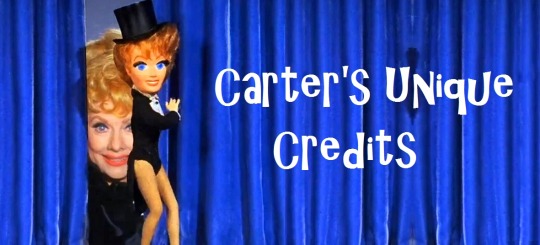
Directed by Herbert Kenwith ~ Written by Larry Rhine and Lou Derman
Synopsis
After bragging to Craig about her perfect driving record, Lucy smashes into a laundry truck. In order to pay for the repairs, she has to go to work at the laundry and keep her identity a secret when Kim and Craig are suddenly plagued with clothing stains.
Regular Cast
Lucille Ball (Lucy Carter), Gale Gordon (Harrison Otis Carter), Lucie Arnaz (Kim Carter), Desi Arnaz Jr. (Craig Carter)
Guest Cast

James Hong (Lee Wong) was born in 1929 and began his screen career in 1954. He has lately been acclaimed as the voice of Mr. Ping in the Kung-Fu Panda franchise. Aside from his nearly 500 screen credits, Hong is one of the founders of the East-West Players, the oldest Asian American theater in Los Angeles. At Desilu, he unsuccessfully auditioned for the role of Sulu in “Star Trek.” This is his only appearance with Lucille Ball.
Mr. Wong is a widower with two young girls. He operates Lee Wong's Hand Laundry on Pine and Hurst.

Lauren Gilbert (Mr. Michaels, Insurance Adjuster) played recurring characters on “Edge of Night” and “Hazel” - both named Harry. This is his only appearance with Lucille Ball.
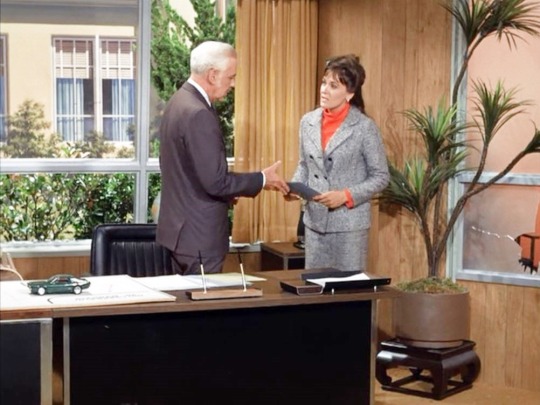
Bee Thompkins (Secretary) had only a handful of other screen credits between 1969 and 1972. Also in 1970, she was one of the passengers in the blockbuster film Airport. She was variously credited as ‘Bea Tompkins’ during her career.
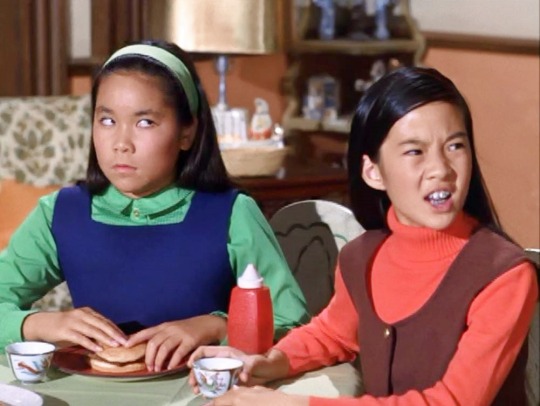
Rosalind Chao (Linda Chang Wong, right) made her screen debut with this episode. She created the role of Soon-Ye Klinger on “M*A*S*H” and “After M*A*S*H” but is perhaps best known for playing Keiko O'Brien on “Star Trek: The Next Generation” and “Deep Space Nine.” During that series she also filmed The Joy Luck Club. She recently guest-starred on TV's “Blackish,” “This is Us,” and “The Catch.”
Heather Lee (Sue Chin Wong, left) makes her only screen appearance in this episode.
Linda Chang and Sue Chin are sisters and the daughters of Lee Wong.

Romo Vincent (Laundry Customer) was a Broadway performer from 1942 to 1959. He played an airline passenger in “Lucy Flies to London” (TLS S5;E6). This is the first of his two episodes of “Here’s Lucy.”
Vincent was cast for his size. He claims his shorts are size 52.
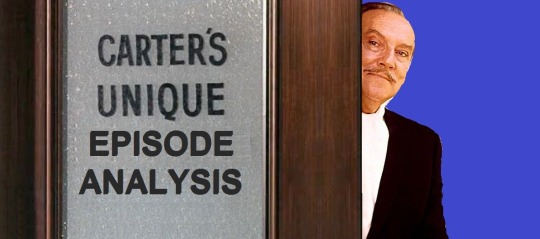
This is the first of nine episodes written by Larry Rhine and Lou Derman. Rhine had been nominated for an Emmy Award in 1963 for writing for “The Red Skelton Show.” He was nominated again in 1978 for an episode of “All in the Family.” Derman was also an Emmy nominee for “All in the Family.” Together they also wrote many episodes of “Mr. Ed.”
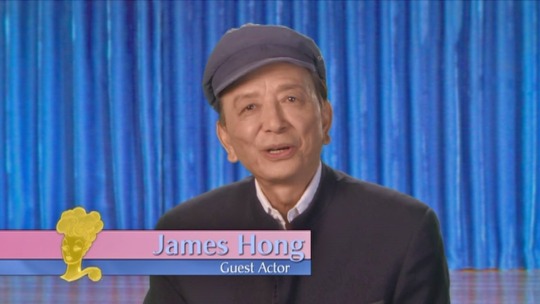
In his DVD introduction to the episode, James Hong tries to diffuse any misinterpretation of Lucy's disguising herself as an Asian character.
“Sometimes it's very offensive for the Asians to see that kind of image. But she was in essence playing that character pointing out how society had this cliched image of the Asians. So she was laughing at herself and and laughing at the society's concept of Asians. To contrast that they had me dress up in this wonderful suit – very elegant!”
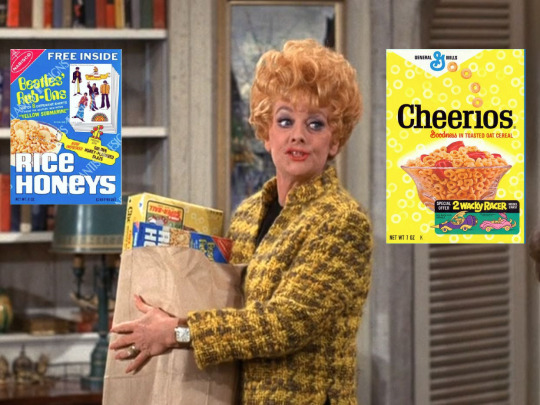
In the opening scene, Lucy comes home with a bag of groceries containing Cheerios. On the bottom right corner of the box it states that a free Super-Ball is inside. [In the inset photo it is for Wacky Racers as a Super-Ball box was not available.] During the summer of 1969, scores of American kids begged their parents to buy the General Mills cereal to get the amazing Super-Ball inside.
Next to that is a box of Nabisco Rice Honeys, also a breakfast cereal. The cereal was first marketed under another name in 1939 and, after several more name changes, was discontinued in 1975. What is unique about this particular box is that it includes free Beatles’ Rub-Ons promoting their movie Yellow Submarine. The film was released in November 1968, about a year before filming. If you saved one of those boxes, they're currently going for over $1,000. In 2014, someone sold one for $1,430.50 at auction!
At the office, Lucy gets a call from Mary Jane. The character does not appear in this episode, but is played by Mary Jane Croft.
Harry is looking for the Treshkin contract.

The car accident costs Lucy $97.50. When Lucy doesn't have money to pay for the damages to Wong's van, he suggests she should “Sell car. Take bus. Leave driving to us.” This was a paraphrasing of the advertising slogan of the Greyhound Bus Company. It was previously quoted in “Lucy Helps Craig Get a Driver’s License” (S1;E24) and “Lucy and the Used Car Dealer” (S2;E9).
When Sue Chin Wong learns that Lucy will be working for her father, she exclaims: “Well, there goes the neighborhood!” This was a common expression used to grouse about integration, which was a hot topic in the late 1960s. To further reinforce the role reversal comedy, the writers give the line to an Asian character.

When Lucy meets Wong's daughters, she greets them in an exaggerated and condescending Chinese accent. The girls look horrified and answer back in voices totally devoid of any Asian influence. To further the humor of Lucy's backward thinking, the girls are eating hamburgers with ketchup, a typical American-style meal.

Mr. Wong's daughters inform Lucy that their father only pays sixty five cents an hour. In late 1969 the minimum wage was $1.30 per hour, but rose to $1.45 per hour in February 1970. The girls explain that their dad thinks that because he's Chinese he can pay “coolie” wages. The word “coolie” refers to an unskilled native laborer generally from India, China, or some other Asian country. Depending on the context, this word can be considered offensive or pejorative.
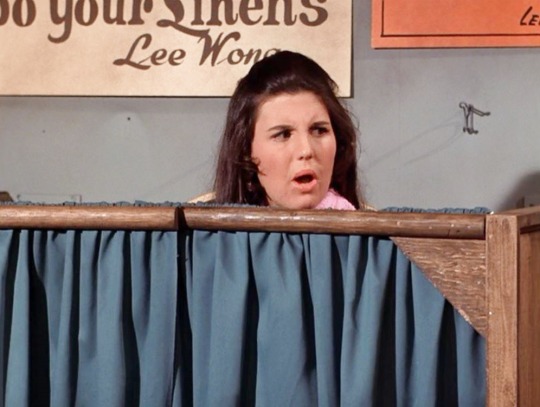
When Kim enters the shop to get a stain out of her new dress, Lucy disguises herself with a bright kimono, thick eyeglasses, and a fringed red lampshade on her head. She disguises her voice to a stereotypical Asian accent by changing her Rs to Ls (ie: “tellycroth lobe”).
After Lucy's true identity has been revealed, Harry says “Well, if it isn't Madam Butterfly.” He is referring to the title character in Madam Butterfly, an Italian opera by Giacomo Puccini that premiered in 1904 and is still in the classical repertory today. In the opera, a 15 year-old Japanese girl falls in love with an American sailor with tragic consequences. The story was also the inspiration for the Broadway musical Miss Saigon (1989) and the play M. Butterfly (1989).
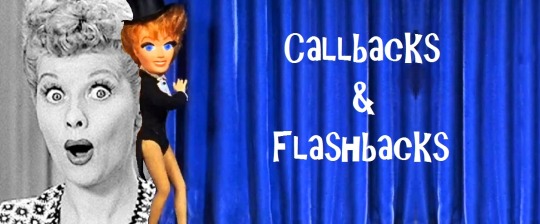
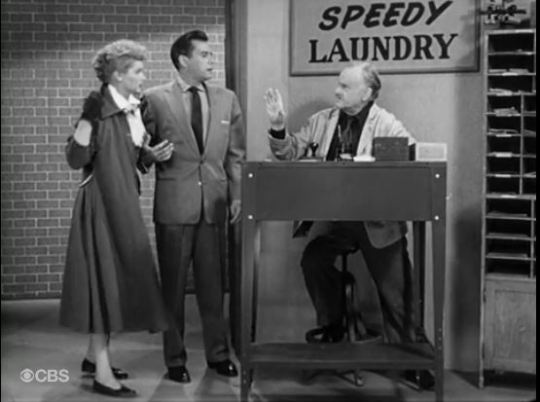
Lucy Ricardo also caused havoc at a laundry in “Bonus Bucks” (ILL S3;E21).

Lucy tells Craig that Mr. Wong is a decorator who is there because she is considering doing the house over in Chinese Modern. Chinese Modern was the style that Carolyn Appleby redecorated her apartment in “Lucy Tells the Truth (ILL S3;E6). Sworn to be truthful, Lucy says it looks like “a bad dream you'd have after eating too much Chinese food.”

Lucy fibs to Craig that Mr. Wong decorated Grauman's Chinese Theatre (everything but the footprints). The iconic Hollywood movie palace was the setting of “Lucy Visits Grauman's” (ILL S5;E1) and the footprints were integral to that episode and the following one, “Lucy and John Wayne” (ILL S5;E2).

Lucy Carmichael also disguised herself as an Asian character in “Lucy and the Soap Opera” (TLS S4;E19).
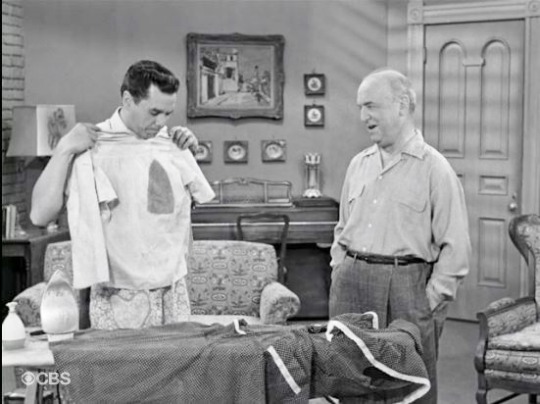
Lucy Carter's ironing skills seem no better than that of Ricky Ricardo and Fred Mertz, who both left their ‘marks’ on the laundry during “Job Switching” (ILL S2;E1).
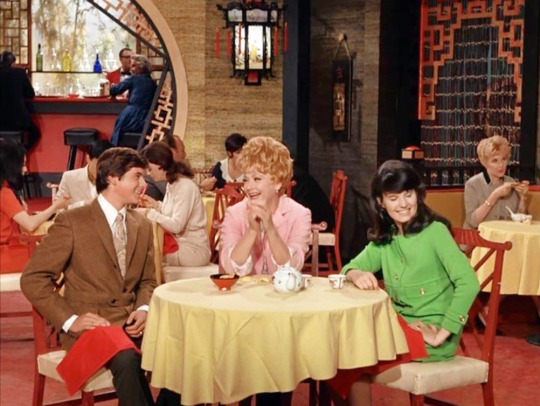
In season one, Lucy Carter celebrated her birthday at a Chinese restaurant.

Ouch! Lucille Ball accidentally scalded her hand during the filming when using the steam press. This is ironic, since the dialogue has Mr. Wong warn Lucy to be “careful with the steam iron” when he first agrees to let her work off her debt.
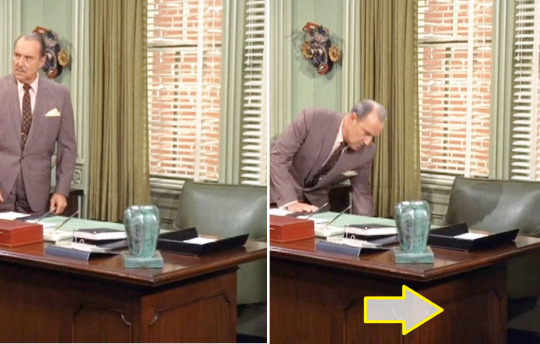
The Shadow Knows! There is a moving shadow across the side of the desk when Harry bends down to get a key from the drawer. The next shot is a close-up (below), which necessitated the camera move that caused the shadow.

Props! Harry offers Lucy a mini-bottle of booze that he got on a flight to Hawaii. It is hidden inside the jade green desk ornament that coincidentally makes its debut with this episode – and disappears thereafter. In the above photo, the bottle is difficult to see. Only the neck of the tiny bottle with its white seal can be seen.

Where the Floor Ends! This time the floor ends in the Chinese Hand Laundry.
Sitcom Logic Alert(s)!
From the time Harry hears Lucy's collision outside his window to Lucy's entrance into the office is a mere 8 seconds! Take into account that she says she left a note for the owner on his windshield – and put the windshield in the front seat!
Mr. Wong arrives with an estimate of the damages on the very same day as the accident.
At the laundry, Lucy immediately knows how to work a commercial laundry press with no instruction.
Even with the accent and disguise, Kim should probably recognize her own mother's voice.

Oops! When Lucy trips and her hat and wig fall off, the black masking placed next to her right ear to hide her red hair stays on. Lucille Ball has to duck down quickly and rip it off.

“Lucy the Laundress” rates 4 Paper Hearts out of 5
This episode feels the most like an episode of “I Love Lucy.” Lucy is caught in a fib, so instead of telling the truth, she goes to elaborate lengths to conceal her lie. The thorny issue of racial sensitivity rears its head when viewed by a modern audience. But it is clear that Lucille Ball was trying to portray Mr. Wong and his family as average Americans, and Lucy's view of Asian culture as backward. It is worth noting that all the Asian characters are actually played by Asian actors. When the young girls call Lucy out for her patronizing attitude, Lucy immediately acknowledges that she's been wrong and the scene (and the comedy) continues without any rancor. The hard-fought Civil Rights battles of the 1960s are slowly having an effect on television.
#Here's Lucy#Lucy the Laundress#Lucille Ball#Gale Gordon#James Hong#Lucie Arnaz#Desi Arnaz Jr.#Laundry#Chinese Laundry#Lauren Gilbert#Bea Thompkins#Rosalind Chao#Heather Lee#Romo Vincent#Larry Rhine#Lou Derman#Herbert Kenwith#Greyhound Bus#Madam Butterfly#1970#CBS#TV
3 notes
·
View notes
Photo

Lucy Liu for The Laundress New York: #OurBeautifulMesses
190 notes
·
View notes
Text
FATHER’S DAY
The death of Lucille Ball’s father at an early age had a great impact. Throughout the four situation comedies built around her, the “Lucy” characters had mothers, but references to their fathers was rare. Here’s a tribute to the precious few dads found in the Lucyverse!
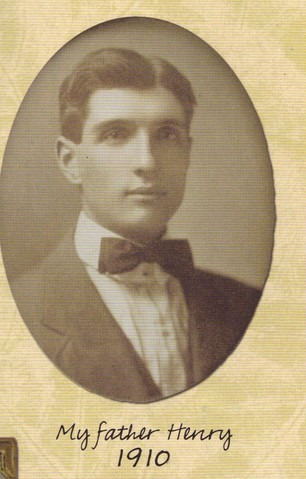
Henry “Had” Durrell Ball (1887-1915) ~ Father of Lucille Ball and Fred Ball.

Desiderio Alberto Arnaz y Alberni II (1894-1973) ~ Father of Desi Arnaz and grandfather of Lucie Arnaz and Desi Arnaz IV. Desi Jr. is now the father of two.
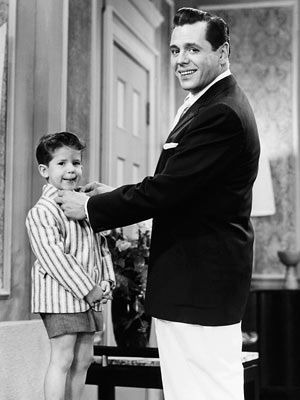
Ricky Ricardo (aka Ricardo Alberto Fernando Ricardo y de Acha aka Enrique Alberto Fernando Ricardo y de Acha III) ~ Father of Ricky Ricardo Jr. (Keith Thibodeaux). Actually, Ricky’s son was played by 8 actors over the course of the series.

In “Return Home From Europe” (ILL S5;E26), Ricky insists that he is not the father of baby Cheddar Chester!
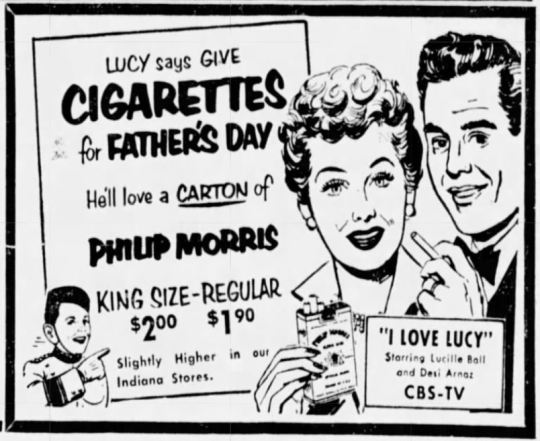
Below are all the fathers on “I Love Lucy”!
But first, a (Father’s Day) word from our sponsor!
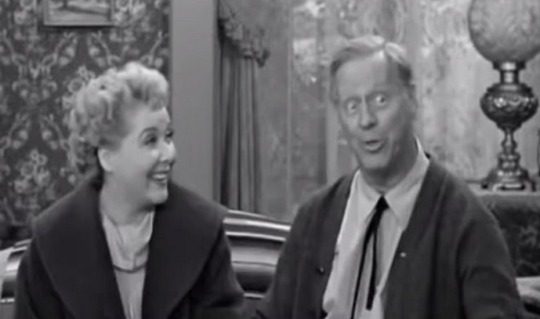
Will Potter ~ Father of Ethel Mertz. Besides Ricky himself, Will Potter (Irving Bacon) is the only father of the main characters on “I Love Lucy.” Although all four have living mothers (two of whom are characters on the show), only Ethel’s father is alive and well and appears on screen in “Ethel’s Hometown” (ILL S4;E16).
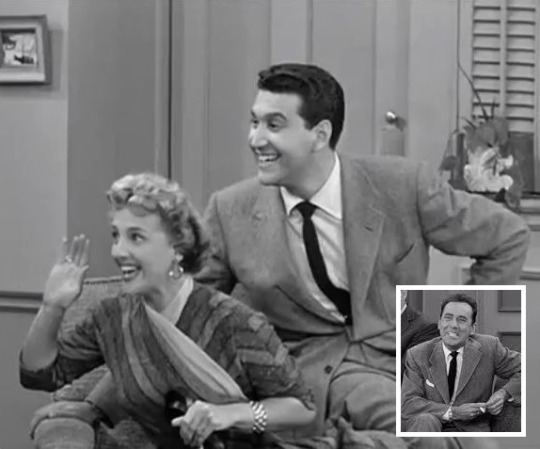
Charlie Appleby ~ Father of Stevie. Charlie makes two appearances on the series, although each time he is played by a different actor: Hy Averback played him in “Baby Pictures” (ILL S3;E5) and George O'Hanlon (inset photo) in “Lucy and Superman” (ILL S6;E13).

Harry Munson ~ Father of Billy. Harry and Grace live about a mile from the Ricardos in Connecticut. Harry is played by Tristram Coffin in two episodes: “Lucy Misses the Mertzes” (ILL S6;E17) and in “The Country Club Dance” (S6;E25).
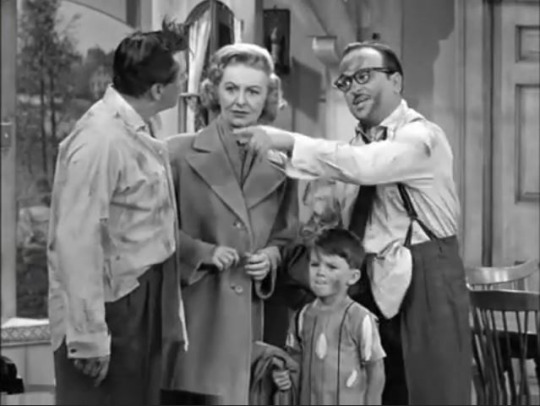
Ralph Ramsey ~ Father of Bruce Ramsey. The Ramseys live across from the Ricardos in Westport. Ralph (Frank Nelson) was only seen in two Connecticut-based episodes: “Lucy Gets Chummy With The Neighbors” (ILL S6;E18) and “The Country Club Dance” (ILL S6;E25), although Nelson appeared in many more episodes as different characters.
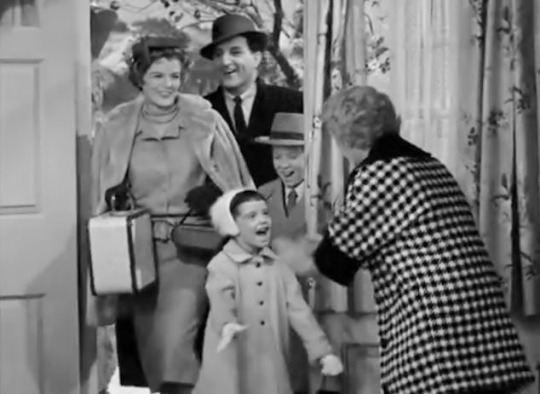
Danny Williams ~ Father of Rusty, Linda and Terry, although Terry does not appear in “Lucy Makes Room For Danny”, the cross-over episode that brought “The Danny Thomas Show” to CBS. In fact, for its first three years, the show was known as “Make Room for Daddy.” Subsequently, Thomas did a sequel called “Make Room for Granddaddy” and Lucille Ball guest-starred on it in 1971.

The Sheriff of Bent Fork, Tennessee ~ Father of twin girls Teensy and Weensy. Will Wright played the character in “Tennessee Bound” (ILL S4;E15).

Mr. Stanley ~ Father to nine girls! When “Lucy Goes To The Hospital” (ILL S2;E16), Ricky meets a man in the fathers’ waiting room (played by Charles Lane) anxiously awaiting the birth of his latest (and he says last) child, whom he hopes will be a boy. His hopes are dashed - times three over!
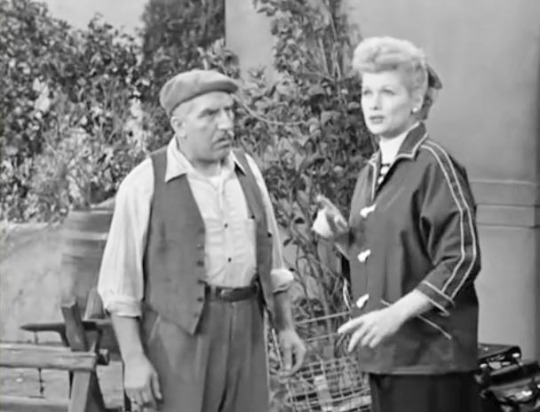
The Italian Farmer ~ in “Lucy’s Bicycle Trip” (ILL S5;E24), claims to have nine children: Teresa, Sofia, Luigi, Pietro, Dino, Gino, Rosa, Mario, and Antonio! The Farmer is played by Mario Siletti, but his "multi bambini” remain off screen!

Ernie Kovacs ~ Father of Kippie and Bette, unseen but mentioned characters in “Lucy Meets the Mustache” (LDCH S3;E3) in 1960. The girls are said to be making friends with Little Ricky, while their father entertains at Lucy and Ricky’s (last) party.
Moving on to the Fathers of “The Lucy Show”...

Theodore J. Mooney ~ Father of Bob, Ted, Arnold, and Rosemary, who was never seen, but is said to live in Trenton and to have had a baby, making Mr. Mooney a grandfather as well! Gale Gordon played Mr. Mooney from 1963 to 1968. If the character was ever given a spin-off, it might have been called “My Three Sons”!
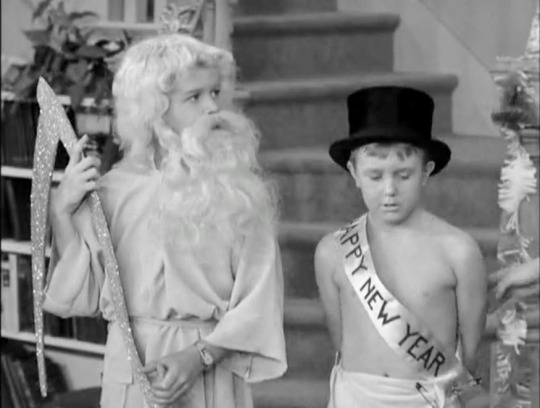
Father Time ~ Played by Sherman Bagley (Ralph Hart) in “Chris’s New Year’s Eve Party” (TLS S1;E14). He is accompanied by Baby New Year played by Jerry Carmichael (Jimmy Garrett). In the series, Sherman’s father Ralph is mentioned, but never seen. Jerry’s dad is deceased and never given a name.

Kenneth Westcott ~ Father of Debbie, who is a friend of Lucy Carmichael’s daughter Chris and Principal of their high school in 1963′s “Lucy is a Chaperone” (TLS S1;E27). He is played by Hanley Stafford.

Mr. Sanford ~ Father of Timmy, who is having a birthday where Lucy and Viv are hired as party planners and the entertainment in “Kiddie Parties, Inc.” (TLS S2;E2). Mr. Sanford is played by Lyle Talbot. If he was ever given a sequel, it might be called “Sanford and Son”!
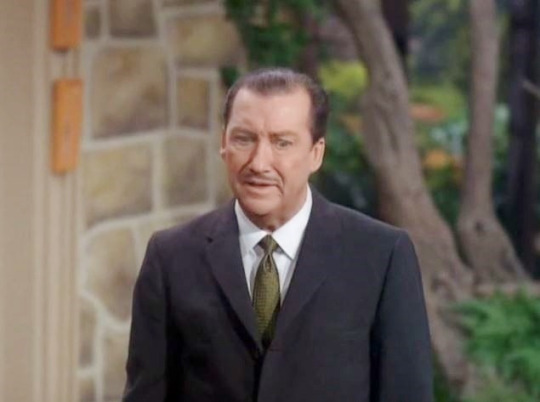
Jonathan Winslow ~ Father of Charlie, Danny and Bobbie (aka Roberta) in “Lucy the Babysitter” (TLS S5;E16). What Lucy doesn’t realize is that the Winslow children are actually baby chimps! Mr. Winslow was played by Jonathan Hole.
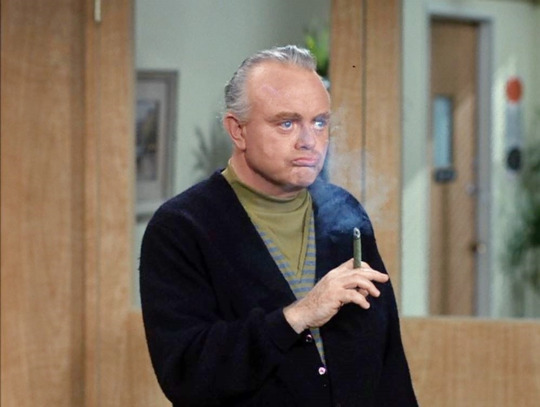
In “Lucy and Harry’s Tonsils” (TLS S2;E5), Mr. Phillips (Jack Collins) plays an father expecting his first child who believes Mr. Mooney is there for the same reason, while Mr. Mooney thinks Mr. Phillips is there for a tonsillectomy! Phillips (having his third child) is similar to the character of Mr. Stanley (who is having his ninth – all girls!) in “Lucy Goes to the Hospital” (ILL S2;E16).

“Lucy Becomes a Father” (TLS S3;E9) finds single mom and widow Lucy Carmichael trying to be both mother and father to her son, Jerry. She joins five other cub scout dads on a weekend away, trying desperately to do what the other dads do. The fathers include (left to right): Hal Smith as Mr. Wilson, George ‘Red’ Fox as George (hidden), Gale Gordon as Mr. Mooney, George Niese as Mr. Carter, and Buster West as Tom. Coincidentally, Gale Gordon had the surnames Carter in “Here’s Lucy” and Wilson in “Dennis the Menace” but neither were dads!
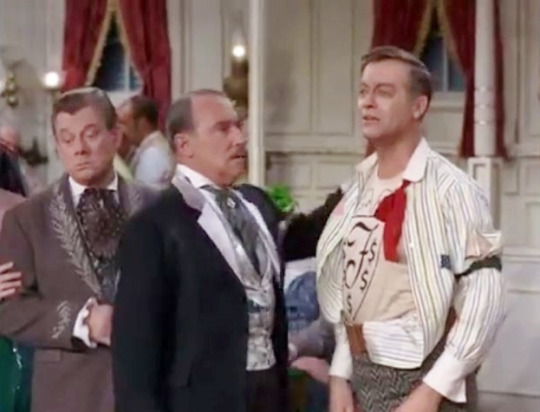
In the play “The Founding of Danfield” staged in “Lucy and Arthur Godfrey” (TLS S3;E23) in 1965, Godfrey plays “Daddy” of Lucybelle (Lucy Carmichael), and [spoiler alert] Conrad P. Field (Mr. Mooney) turns out to be the daddy of the Honest-But-Poor Piano Player Dan (Vinnie, played by Max Showalter). In real life, Godfrey was the father of three.
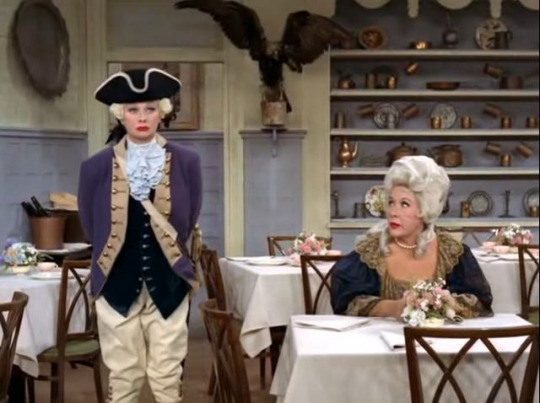
The Father of Our Country ~ George Washington, as embodied by Lucy Carmichael when “Lucy and Viv Open a Restaurant” (TLS S2;E20). Viv (Vivian Vance) dresses a George’s wife, Martha, to promote their new Colonial-themed restaurant.

In “Lucy the Gun Moll” (TLS S4;E25), Lucille Ball plays both Lucy Carmichael and a look-alike gun moll named Rusty, who performs the Cole Porter song “My Heart Belongs to Daddy”!
And now the Dads of “Here’s Lucy”....
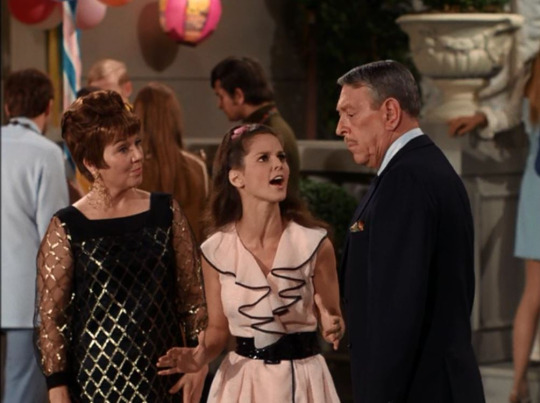
Mr. Caldwell ~ Father of Laurie in “Mod, Mod Lucy” (HL S1;E1), the very first episode of “Here’s Lucy.” Lew Parker played the over-protective dad of teenage Laurie (Nancy Roth). His wife is played by Nancy Howard. Parker was best known for playing the father of another TV character, Ann Marie (Marlo Thomas) on “That Girl.” In real-life, Marlo’s father was Lucy’s friend and co-star - one of the most famous daddies on TV - Danny Thomas!
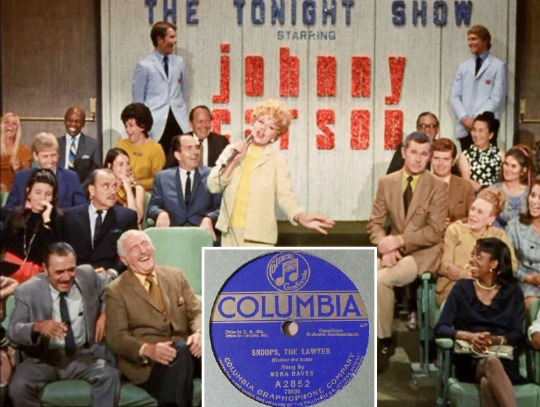
On “Lucy and Johnny Carson” (HL S2;E11), while appearing on “The Tonight Show” and playing Stump the Band, Lucy Carter chooses a song titled “Snoops the Lawyer” that she says her father sang to her when she was a child. This is the only mention of her father on the series. Coincidentally, Ball’s real mother is one of the audience members (Carson is sitting on the arm of her chair). Since the song was not written until 1920, and Lucille Ball’s real father Henry died in 1915, this cannot be a real-life recollection from Lucy.

Lee Wong ~ Father of Linda Chang and Sue Chin in “Lucy the Laundress” (HL S2;E17). The single father and business owner was played by James Hong.

Moose Manley ~ Father of milquetoast Wally in “Lucy and Wally Cox” (HL S2;E21). Moose was played by Alan Hale Jr. and his timid son by Wally Cox (insert).
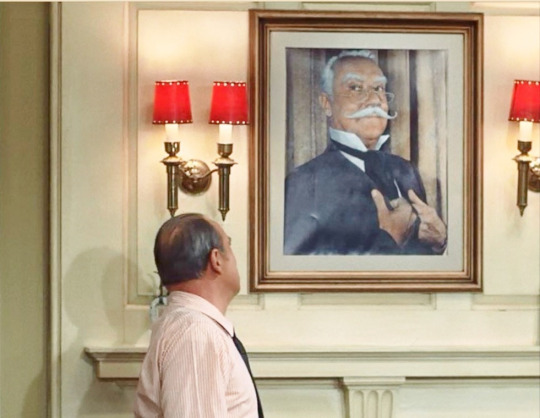
Harrison Otis Carter the First ~ Great Grandfather of Harry Carter IV (aka Harry). Gale Gordon’s image was used to create Harry’s great grandfather. Harry claims he was one of the founders of Sinclairville, New York, and was father of 17 children!
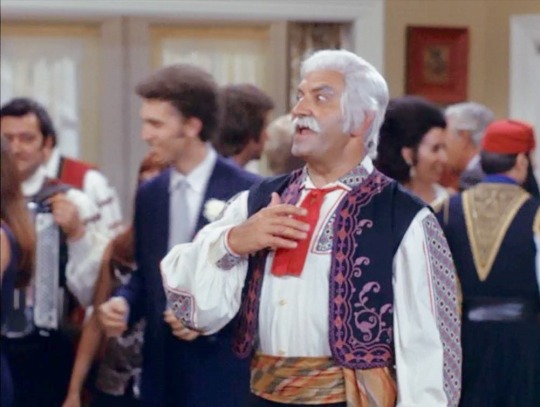
Konstantin Kasos ~ Grandfather of the Bride in “Lucy’s Wedding Party” (HL S3;E8). The role was played by Bruce Gordon (”The Untouchables”) who was really just 55 years old playing a 77 Greek granddaddy.

Vincent Price - Father of Victoria aka “Little Vicky”, the name of Price’s real-life daughter, who is mentioned by Lucy, but does not appear in the episode “Lucy Cuts Vincent’s Price” (HL S3;E9).

Alfredo Colucci ~ Father of Ricardo, Anna Maria, Louisa, Luigi, Vincenzo, Dino, Lucrezia, Alfredo Jr., Margarito, Bruno, Rosa, and Frederico - all of whom appear in the final moments of “Lucy and Harry’s Italian Bombshell” (HL S4;E3) starring Kaye Ballard. Emile Autuori plays Alfredo, but the twelve children appear uncredited.

Claude Wolff ~ Husband of Petula Clark, who was noticeably pregnant when they played themselves on a “Here’s Lucy” in 1972. In real-life, Wolff became a dad for the third time with the birth of his first son, Patrick.
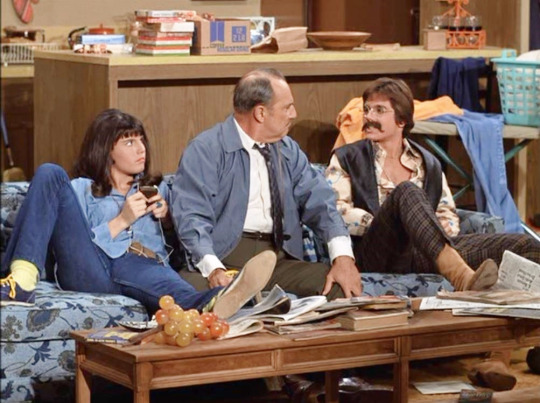
Harry Carter (Gale Gordon) finally got to play a working class dad to two unambitious teens when he appeared in a TV commercial during “Lucy and Cousin Ernie’s Fun Farm” (HL S1;E23) in 1969.

Harry Carter (Gale Gordon) pretends to be a husband and father (to be) when he convinces Lucy to play his pregnant wife to scare of a domineering suitor (Jean Willes) in “Lucy, The Part-Time Wife” (HL S3;E14).
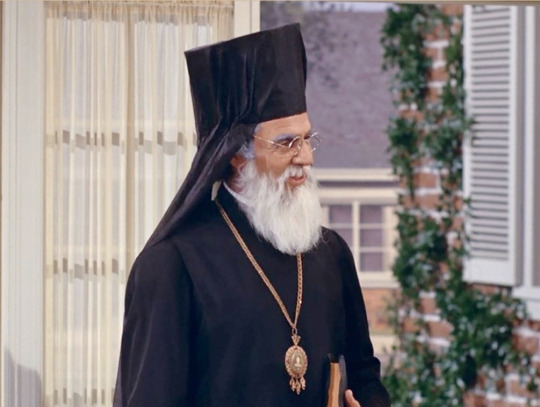
The Lucyverse has plenty of room for fathers of all kinds. Father Lambros (Paul Picerni) showed up for a Greek wedding in “Lucy’s Wedding Party” (HL S3;E8).
And Finally, “Life With Lucy
All Lucy Fathers come back to Gale Gordon - a man who never had children in real life!

Curtis McGibbon ~ Father of Ted McGibbon and Grandfather of Ted’s children Rebecca and Kevin. Gale Gordon played Curtis, the patriarch on “Life With Lucy,” with Larry Anderson as Ted, Jenny Lewis as Becky, and Philip Amelio as Kevin.
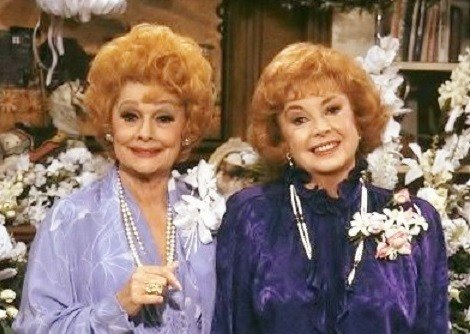
In “Mother of the Bride” (LWL S1;E8) in 1986, Lucy Barker and her sister Audrey (Audrey Meadows) mention their father during a private conversation in the kitchen.
#Lucille Ball#Fathers Day#Fathers#Dads#Daddies#Pops#Papa#i love lucy#the lucy show#Here's Lucy#Life With Lucy#Gale Gordon#desi arnaz
2 notes
·
View notes
Text
“Here’s Lucy” ~ Season 2

A handy dandy guide to helping you find your favorite episode blogs here at Papermoon Loves Lucy. Click on the hyperlinks to be taken directly to that episode’s trivia, background, and bloopers!

“Lucy Goes to the Air Force Academy: Part 1” (S2;E1) ~ September 22, 1969

“Lucy Goes to the Air Force Academy: Part 2” (S2;E2) ~ September 29, 1969

“Lucy and the Indian Chief” (S2;E3) ~ October 6, 1969

“Lucy Runs the Rapids” (S2;E4) ~ October 13, 1969

“Lucy and Harry’s Tonsils” (S2;E5) ~ October 20, 1969

“Lucy and the Andrews Sisters” (S2;E6) ~ October 27, 1969

“Lucy’s Burglar Alarm” (S2;E7) ~ November 3, 1969

“Lucy at the Drive-In Movie” (S2;E8) ~ November 10, 1969

“Lucy and the Used Car Dealer” (S2;E9) ~ November 17, 1969

“Lucy, the Cement Worker” (S2;E10) ~ November 24, 1969

“Lucy and Johnny Carson” (S2;E11) ~ December 2, 1969

“Lucy and the Generation Gap” (S2;E12) ~ December 8, 1969

“Lucy and the Bogie Affair” (S2;E13) ~ December 15, 1969

“Lucy Protects Her Job” (S2;E14) ~ December 22, 1969

“Lucy the Helpful Mother” (S2;E15) ~ December 29, 1969

“Lucy and Liberace” (S2;E16) ~ January 5, 1970

“Lucy the Laundress” (S2;E17) ~ January 12, 1970

“Lucy and Lawrence Welk” (S2;E18) ~ January 19, 1970

“Lucy and Viv Visit Tijuana” (S2;E19) ~ January 26, 1970

“Lucy and Ann-Margret” (S2;E20) ~ February 2, 1970

“Lucy and Wally Cox” (S2;E21) ~ February 9, 1970

“Lucy and Wayne Newton” (S2;E22) ~ February 16, 1970

“Lucy Takes Over” (S2;E23) ~ February 23, 1970

“Lucy Competes with Carol Burnett” (S2;E24) ~ March 2, 1970
SEASON SUMMARY
Regular Cast: Lucille Ball (Lucy Carter), Gale Gordon (Harrison Otis Carter), Lucie Arnaz (Kim Carter), Desi Arnaz Jr. (Craig Carter)
Recurring Characters: Mary Jane Croft (Mary Jane Lewis), Vivian Vance (Vivian Jones)
Celebrity Cast playing Characters: Milton Berle (Cheerful Charlie), Paul Winchell (Jeweler/Knife Thrower, Carlo), Wally Cox (Wally Manley), Alan Hale Jr. (Moose Manley), Carol Burnett (Carol Krausmeyer)
Celebrity Cast playing Themselves: Patty Andrews, Johnny Carson, Ed McMahon, Jack LaLanne, Liberace, Lawrence Welk, Ann-Margret, Wayne Newton, Jerry Newton, Robert Alda
Guest Cast playing Characters: Roy Roberts, Iron Eyes Cody, Paula Stewart, Mary Wickes, Gary Morton, Sid Gould, James Hong, Lyle Talbot, Vanda Barra
Live Animal Cast: Lord Nelson (Bogie), Happy & Puppies in “The Bogie Affair”; Dog in “Lucy at the Drive-In Movie”; Myna Bird (Bruce), Chimp (Irving), Parrot (Radish), Leopard, Ring-Tailed Cat, Skunk (Breath of Spring), Hamsters, Canaries, Doves, & Bunnies in “Lucy, the Helpful Mother”; Miniature Horse (Tiny Tim), Cow & Horses in ”Lucy and Wayne Newton”; Sheep in ”Lucy and the Indian Chief”
There were 24 new episodes
The season opened with four episodes shot on location at the U.S. Air Force Academy in Colorado, the Colorado River, and in Arizona. One episode was shot on location at Wayne Newton’s Casa Shenandoah outside Las Vegas (”Lucy Meets Wayne Newton”).
Written by: Milt Josefsberg, Ray Singer, Gene Thompson, David Ketchum, Bruce Shelly, George Balzer, Sam Perrin, Fred S. Fox, Seaman Jacobs, Pat McCormick, Jim McGinn, Ralph Goodman, Al Schwartz, Larry Rhine, Lou Derman, Martin A. Ragaway, William Raynor, Myles Wilder
Directed by George Marshall (E1-11), Jack Baker (E12 & 16), Herbert Kenwith (E13, 15, 17-20), Danny Dayton (E14 & 22), Jay Sandrich (E21, 23, 24)
Total Binge Hours: 12 hours (with commercials)
Papermoon’s Full Moon Pick: “Lucy and the Used Car Dealer” (E9)
Papermoon’s Half Moon Pick: “Lucy, the Cement Worker” (E10)
Season 2 was #6 (up from #9) in the ratings with a 23.9 share (up one tenth of a point)
Season 2 was released on DVD on November 3, 2009

#Here's Lucy#Lucille Ball#Gale Gordon#Vivian Vance#Mary Jane Croft#Lucie Arnaz#Desi Arnaz Jr.#Wayne Newton#Carol Burnett#Milton Berle#Paul Winchell#Wally Cox#Patty Andrews#Johnny Carson#Liberace#Lawrence Welk#Ann-Margret#CBS#TV#1969#1970#Las Vegas#US Air Force Academy#The Tonight Show#George Marshall#Jack Baker#DVD
4 notes
·
View notes
Text
LUCY: 40 YEARS OF TELEVISION
1970 Part One ~ JANUARY to JUNE

A new decade of “Lucy” begins! The second half of season two of “Here’s Lucy” includes appearances by Liberace, Carol Burnett, Lawrence Welk, and Wayne Newton. Plus talk show appearances with Johnny Carson, Irv Kupcinet, Ed Sullivan, David Frost, and Mike Douglas.
"Lucy and Liberace" (HL S2;E16) ~ January 5, 1970

Mr. Showmanship meets the Queen of Comedy to kick off the new year. Liberace brought $50,000 worth of his spectacular wardrobe to the set, and Lucille Ball hired a round-the-clock security guard to ensure its safety. The tuxedo jacket that lights up in the dark made its debut on this show.
"Lucy the Laundress" (HL S2;E17) ~ January 12, 1970

This is the first of nine episodes written by Larry Rhine and Lou Derman. In his introduction to the episode on the series DVD, guest star James Hong tries to diffuse any misinterpretation of Lucy’s disguising herself as an Asian character.
“The Ed Sullivan Show” (S22;E17) ~ January 18, 1970

From New York City, Lucille Ball and her children are introduced from the audience. Celebrity audience shout-outs were a tradition on “The Ed Sullivan Show.” On stage, June Allyson sings showtunes, Buddy Greco performs, and boxer Muhammad Ali presents scenes from his Broadway play Buck White.
"Lucy and Lawrence Welk" (HL S2;E18) ~ January 19, 1970

“Wunerful wunerful” bandleader Lawrence Welk guest stars as himself with Vivian Vance back as Vivian Jones. This is the first of five episodes written by Martin A. Ragaway.
“Garroway” (S1;E38) ~ January 21, 1970

Lucille Ball is a guest on Dave Garroway’s new (but short-lived) talk show on WNAC-TV, Boston, which Garroway (”The Today Show”) hoped would be picked up for national syndication. The program lasted into early 1970 and never aired outside Boston. The show was canceled when management decided to show old movies instead of local live shows.
"Lucy and Viv Visit Tijuana" (HL S2;E19) ~ January 26, 1970

The alternate title of this episode was “Lucy and Vivian Vance.” The two titles are used interchangeably, even on the series DVD. This episode is very closely modeled on “Lucy Goes To Mexico,” a 1958 episode of “The Lucy-Desi Comedy Hour.”
“The David Frost Show” ~ January 29, 1970

David Frost welcomes Lucille Ball, Harry Goz, Harry Lorayne, and Tom Wolfe to his talk show.
“The Dick Cavett Show” ~ January 26, 1970

Dick Cavett interviews Lucille Ball and Charles Aznavour.
“The Mike Douglas Show” ~ January 29, 1970

Tony Sandler and Ralph Young are Mike’s co-hosts. Lucille Ball and Allen Funt are their guests. Funt will guest star on a future “Here’s Lucy.”
“The Irv Kupcinet Show” ~ February 1, 1970

Lucille Ball is a guest on this Chicago-based talk show along with Connie Stevens, Patachou, and Ashley Montagu.
"Lucy and Ann Margret" (HL S2;E20) ~ February 2, 1970

The date this episode first aired the 27th Annual Golden Globe Awards was held and broadcast on NBC. Lucille Ball (who was not present) was nominated but lost to a tie between Carol Burnett and Julie Sommars. This appearance by Ann-Margret was in return for Lucille guest-starring on her 1969 special.
"Lucy and Wally Cox" (HL S2;E21) ~ February 9, 1970

Wally Cox was one of Lucille Ball’s favorite performers. Here he plays an introvert that Lucy tries to coax out of his shell. Alan Hale Jr. guest stars. This is the first of three episodes to be directed by Jay Sandrich.
"Lucy and Wayne Newton" (HL S2;E22) ~ February 16, 1970

Second unit footage of the Las Vegas strip and location footage at Wayne Newton’s ranch in the San Fernando Valley make-up this episode. Lucie and Desi Jr. ride dancing horses!
"Lucy Takes Over" (HL S2;E23) ~ February 23, 1970
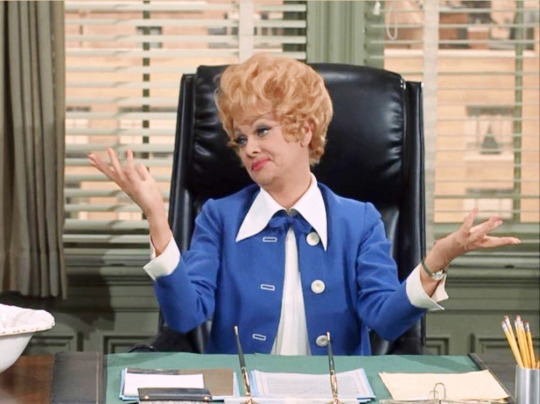
This is the only episode written by William Raynor and Miles Wilder. Lucille Ball’s real-life family tree is used as a basis for some of the details in this episode.
“The Tonight Show Starring Johnny Carson” ~ February 23, 1970

Johnny Carson’s guests are Lucille Ball and Buddy Hackett. The musical guest is Roger Miller. Hackett had appeared in “Lucy and the Stolen Stole” (TLS S6;E19) in January 1968.
"Lucy Competes with Carol Burnett" (HL S2;E24) ~ March 2, 1970

Carol Burnett returns, this time as a secretary named Carol Krausmeyer. The competition is the annual ‘Secretary Beautiful Contest’ hosted by Robert Alda. The season ended with the show #6 in the Nielsen Ratings with a 23.9 share, up slightly from season one.
“The David Frost Show” ~ May 26, 1970

David Frost welcomes Lucille Ball, Carol Burnett, and George Burns to his talk show.
ALSO in 1970...
“The Kraft Music Hall Presents Desi Arnaz” (S3;E16) ~ February 4, 1970

On NBC, Desi Arnaz is joined by his children, Vivian Vance, Bernadette Peters, and musical group The Carnival. Comedy sketches include Desi Arnaz playing an over-aged band leader at Prom. Performances include:
Desi Arnaz: "Babalu", "Cuban Pete" and "Turn Around"
Vivian Vance and Bernadette Peters: "Chewi Chewi" and "I Didn't Know What Time It Was"
Desi Arnaz, Desi Arnaz Jr and Lucie Arnaz: "Straw Hat Song"
Desi Arnaz Jr and Lucie Arnaz: "Under The Bamboo Tree"
Directed by Dwight Hemion. Lucille Ball does not appear.
#Lucille Ball#Here's Lucy#Carol Burnett#Vivian Vance#David Frost#The Tonight Show#Johnny Carson#Wayne Newton#Wally Cox#Desi Arnaz Jr.#Ann-Margret#Irv Kupcinet#Mike Douglas#The Mike Douglas Show#Kup's Show#The David Frost Show#Lawrence Welk#The Ed Sullivan Show#Ed Sullivan#1970#CBS#TV#Dave Garroway#Garroway#Dick Cavett
2 notes
·
View notes